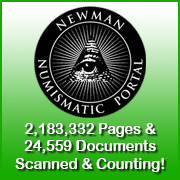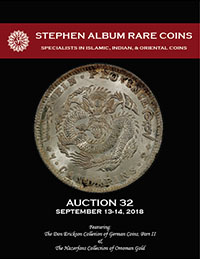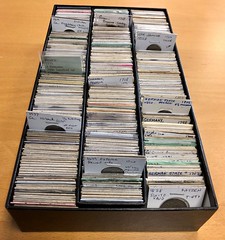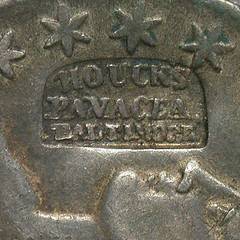
About UsThe Numismatic Bibliomania Society is a non-profit association devoted to the study and enjoyment of numismatic literature. For more information please see our web site at coinbooks.org SubscriptionsThose wishing to become new E-Sylum subscribers (or wishing to Unsubscribe) can go to the following web page link MembershipThere is a membership application available on the web site Membership Application To join, print the application and return it with your check to the address printed on the application. Print/Digital membership is $40 to addresses in the U.S., and $60 elsewhere. A digital-only membership is available for $25. For those without web access, write to: Terry White, Treasurer AsylumFor Asylum mailing address changes and other membership questions, contact Terry at this email address: terrywhite5475@yahoo.com SubmissionsTo submit items for publication in The E-Sylum, write to the Editor at this address: whomren@gmail.com BUY THE BOOK BEFORE THE COINSale Calendar
|
- WAYNE'S WORDS: THE E-SYLUM AUGUST 26, 2018
- 2018 ANA OUTSTANDING CLUB PUBLICATIONS
- 2018 NUMISMATIC LITERARY GUILD AWARDS
- NEW BOOK: FAKE COIN BIBLE
- NEW BOOK: COINS MINTED BY THE KNIGHTS IN MALTA
- NEW BOOK: 2019 CATALOG OF WORLD COINS 2001-DATE
- NNP ADDS NATIONAL BANK CHARTER INFORMATION
- 1892 COLUMBIAN EXPOSITION GLASS MEDAL
- DON BAILEY'S ORDER OF THE AZTEC EAGLE
- NOTES FROM E-SYLUM READERS: AUGUST 26, 2018
- METAL-TYPER TOKENS
- ELLIS AND READ PERPETUAL CALENDAR MEDALS
- VOCABULARY TERM: SIGNATURE
- LEWIS GRAUER (1854-1918)
- HARVEY STACK'S NUMISMATIC FAMILY, PARTS 23-25
- STEPHEN ALBUM AUCTION 32 HIGHLIGHTS
- SELECTIONS FROM THE HOLABIRD 2018 NCTA SALE
- SELECTIONS FROM THE RAY BENTLEY COLLECTION
- DIX NOONAN WEBB OCTOBER 2018 BANKNOTE SALE
- NUMISMATIC NUGGETS: AUGUST 26, 2018
- WAYTE RAYMOND'S POPULAR ALBUM SERIES
- WAYNE'S NUMISMATIC DIARY: AUGUST 26, 2018
- KELLEN HOARD'S 2018 WORLD'S FAIR OF MONEY REPORT
- 2018 WORLD'S FAIR OF MONEY EXHIBITS
- COINS FROM THE WRECK OF LE CHAMEAU
- KLIMT ON COINS
- MORE COLLECTIVE "JIGSAW PUZZLE" COIN DESIGNS
- RUSSIAN ARCHEOLOGISTS DISCOVER BEARD TOKEN
- TANK MUSEUM EXHIBITS VICTORIA CROSS MEDALS
- EAGLE SCOUT MEDAL OWNER SOUGHT
- WYTHEVILLE, VA VOUCHERS
- LOOSE CHANGE: AUGUST 26, 2018
Click here to access the complete archive a
Click here to unsubscribe (scroll down)
To comment or submit articles, reply to whomren@gmail.com
Content presented in The E-Sylum is not necessarily researched or independently fact-checked, and views expressed do not necessarily represent those of the Numismatic Bibliomania Society.
WAYNE'S WORDS: THE E-SYLUM AUGUST 26, 2018
 New subscribers this week include: Taylor Hartley. Welcome aboard! We now have 5,785 subscribers.
New subscribers this week include: Taylor Hartley. Welcome aboard! We now have 5,785 subscribers.
Thank you for reading The E-Sylum. If you enjoy it, please send me the email addresses of friends you think may enjoy it as well and I'll send them a subscription (but let me know if they are located in the European Union). Contact me at whomren@gmail.com anytime regarding your subscription, or questions, comments or suggestions about our content.
This week we open with two articles on numismatic literature awards from the recent ANA World's Fair of Money, three new books, and a report from the Newman Numismatic Portal.
Other topics this week include Don Bailey, Lewis Grauer, Harvey Stack, metal-typer tokens, perpetual calendar medals, selections from multiple numismatic auction sales, ANA exhibits, Klimt on coins, jigsaw puzzle designs, and Eagle Scout medals.
To learn more about the Numismatic Literary Guild, the Fake Coin Bible, National Bank charters, Queen Azarmidokht, the Lucas Secret Service, the 1802 Half Dime, and Russian beard tokens, read on. Have a great week, everyone!
Wayne Homren
Editor, The E-Sylum
2018 ANA OUTSTANDING CLUB PUBLICATIONS
Congratulations to Maria Fanning, editor of our print publication The Asylum, for winning second place for Specialty Publications in the American Numismatic Association's 2018 Outstanding Club Publications competition. Here's the complete list of winners in all categories. Great job, everyone! -Editor
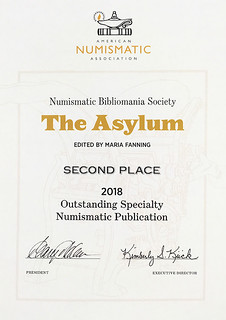 Each year since 1971, the American Numismatic Association has recognized the best journals and newsletters produced by ANA-member organizations. Entries in this year’s
Outstanding Club Publications competition were judged in four categories: regional, local, specialty and electronic.
Each year since 1971, the American Numismatic Association has recognized the best journals and newsletters produced by ANA-member organizations. Entries in this year’s
Outstanding Club Publications competition were judged in four categories: regional, local, specialty and electronic.
Regional Clubs:
Third—FUN Topics, Florida Numismatic Association (Joshua McMorrow-Hernandez, editor)
Second—TNA News, Texas Numismatic Association (Ron Kersey, editor)
First—The California Numismatist, Numismatic Association of Southern California and California State Numismatic Association (Greg Burns, editor)
Local Clubs:
Third—Hemet Numismatists, Hemet Coin Club (Jim Phillips, editor)
Second—Pocket Change, Albuquerque Coin Club (Phil Vitale, editor)
First—The Cincinnati Numismatist, Cincinnati Numismatic Association (David G. Heinrich, editor)
Specialty Clubs:
Third—Bo Tales, The Original Hobo Nickel Society (Ralph Winter, editor)
Second—The Asylum, Numismatic Bibliomania Society (Maria Fanning, editor)
First—International Bank Note Society Journal, International Bank Note Society (Alexander Kort, editor)
Electronic Newsletters:
Since we have an ANA Edition of The E-Sylum we don't enter it in the contest. -Editor
Third—BECC News, Boeing Employees’ Coin Club (Truus Lagerman, editor)
Second—Madison County Coin Club Newsletter, Madison County Coin Club (Harold Fears, editor)
First—PAN eNEWS, Pennsylvania Association of Numismatists (Patrick McBride, editor)
Pat McBride was also a Glenn Smedley Memorial Award recipient, along with Roger Urce, Gerald Tebben, Steven J. D’Ippolito and Patrick A. Heller. Congratulations to all. -Editor
Pat McBride is well known for his dedication to the Pennsylvania Association of Numismatists (PAN). He has been involved with the state organization since 1984 and has brought it into the 21st century through his work on the association’s dynamic website and award-winning online PAN eNEWS newsletter, which won first place this year in the ANA’s Outstanding Club Publications competition (electronic category). McBride also coordinates many aspects of PAN’s two annual coin shows. His influence is evident throughout the bourse floor thanks to his graphic-design skills, open lecture-area concept, John Burns reference library and his humorous and self-deprecating “Rare Coin Basics” lectures for hobby newcomers.
To read the complete press release, see:
Numismatic Influencers Receive Awards During World's Fair of Money
(https://www.money.org/uploads/pdfs/
Numismatic%20Influencers%20Receive%20Awards.pdf)

2018 NUMISMATIC LITERARY GUILD AWARDS
The Numismatic Literary Guild (NLG) is a separate organization from ours, the Numismatic Bibliomania Society (NBS). But we share a love of the numismatic hobby and numismatic research and writing in particular. This NLG press release lists the NLG award winners for 2018, announced at last week's NLG Bash at the American Numismatic Association World's Fair of Money in Philadelphia. Congratulations to all of the winners. -Editor
The Numismatic Literary Guild (NLG), a nonprofit organization composed of editors, authors, writers, bloggers and content producers who cover news and feature stories about all forms of money, medals and tokens as collectibles, presented its annual awards for 2018 on Thursday, August 16, in Philadelphia. This year marked NLG's 50th anniversary.
For information about the NLG, visit www.NLGonline.org. A membership application is available online at www.nlgonline.org/NLG_Member_Form.pdf. To be eligible for consideration in any of the 2018 Numismatic Literary Guild award categories, entries must have been published, released, or posted on the Internet between May 1, 2017 and April 30, 2018.
These are the 2018 winners:
BOOK OF THE YEAR
Saint-Gaudens Double Eagles as Illustrated by the Phillip H. Morse & Stephen Duckor Collections
Roger Burdette
BEST U.S. COIN BOOK
Saint-Gaudens Double Eagles as Illustrated by the Phillip H. Morse & Stephen Duckor Collections
Roger Burdette
BEST PRE-1500 WORLD COIN BOOK
The Image of Political Power in the Reign of Nerva, AD 96-98
Nathan T. Elkins
BEST 1500 TO PRESENT WORLD COIN BOOK
A Monetary History of Central America
Brian Stickney
EXTRAORDINARY MERIT
Fake Coin Bible
Sebastian Wieschowski
BEST WORLD PAPER MONEY BOOK
Standard Catalog of World Paper Money, Modern Issues
Tracy L. Schmidt, Editor
BEST TOKENS & MEDALS BOOK
Forgotten Colorado Silver
Robert D. Leonard, Kenneth Hallenbeck and Adna G. Wilde
BEST NUMISMATIC INVESTMENT BOOK
Silver: Everything You Need to Know to Buy and Sell Today
Jeff Garrett
U.S. COINS TO 1900 ARTICLE
"Popular Morgans Soaked Up Silver"
R. W. Julian
Numismatic News
U.S. COINS 1901 TO DATE ARTICLE
"The Identity of Pratt's Indian"
Allen Schein
The Numismatist
BEST ANCIENTS ARTICLE
"NGC Ancients: Sea Creatures on Greek Coins"
David Vagi
NGC eNews
BEST WORLD COINS 1500 TO DATE ARTICLE
"Augustine Dupre, Engraver General of the French Revolution"
Eric Brothers
The Numismatist
BEST U.S. PAPER MONEY ARTICLE
"The Stockyards National Bank of Fort Worth"
Frank Clark
Paper Money
BEST WORLD PAPER MONEY ARTICLE
"Rule Britannia! BoE's Warrior Queen"
Dr. K. A. Rodgers
Australasian Coin & Banknote Magazine
BEST TOKENS AND MEDALS ARTICLE
"A Navy Chaplain's Treasured Memento"
Ron Cheek
Medal News
BEST NUMISMATIC HISTORY OR PERSONALITIES ARTICLE
"Women and Coins"
Kris Kudenholdt
NGC eNews
ED REITER MEMORIAL AWARD FOR BEST COLUMN OR SERIES
"The Curious Collector"
Len Augsburger
E-Gobrecht
BEST NUMISMATIC SPOT NEWS, MARKETPLACE OR ANALYSIS ARTICLE
"Gold Sovereigns & Triple Unites Lead British Gold Coins Auctioned in New York"
Greg Reynolds
CoinWeek.com
BEST ARTICLE OR STORY OF THE YEAR
"U.S. Money Doctors in Latin America: Between War and Depression, the Short-Lived Reinstatement of the Gold Standard"
Gilles Bransbourg
ANS Magazine
BEST PERIODICAL
COINage Magazine
Scott A. Travers, Executive Editor and Lynn Varon, Managing Editor
BEST CLUB OR NONPROFIT NUMISMATIC PERIODICAL
The Gobrecht Journal
Bill Bugert, Editor
BEST ONLINE NEWS SITE
CoinsWeekly.com
Dr. Ursula Kampmann, Editor
BEST DEALER OR INDUSTRY WEBSITE
NGCcoin.com
Numismatic Guaranty Corporation
BEST NUMISMATIC SOCIAL MEDIA PLATFORM OR COIN COLLECTOR FORUM
Coin Collectors Blog
Scott A. Barman, Editor
THE MAURICE M. GOULD MEMORIAL AWARD FOR BEST COLUMN
"Money Talk"
Frank J. Colletti
Lost Treasure Magazine
BEST PORTFOLIO
Steve Roach
Coin World
BEST NUMISMATIC DEALER WEB SITE
Coins.HA.com
Paul Minshull, Michael Weems, Brian Shipman, Ryan Sokol and James L. Halperin
BEST NON-TRADE WEB SITE
nnp.wustl.edu
The Newman Numismatic Portal
Len Augsburger
BEST BLOG
The Money Connoisseur
Scott A. Travers
bottomlineinc.com
BEST SOFTWARE OR APP
HA.com/live
Heritage Live
Paul Minshull, Michael Weems, Brian Shipman, Ryan Sokol and James L. Halperin
BEST U.S. COINS AUCTION CATALOG
2018 FUN, Platinum Night
Heritage Auctions
BEST WORLD COINS AUCTION CATALOG
2017 ANA Auction, Platinum Night
Heritage Auctions
BEST PAPER MONEY AUCTION CATALOG
The Joel Anderson Collection
Stack's Bowers Galleries
BEST BOOKS OR EXONUMIA AUCTION CATALOG The 2018 New York Book Auction Kolbe & Fanning
LEE MARTIN FOUNDER'S AWARD
The Rosen Numismatic Advisory
Maurice H. Rosen, Editor and Publisher
BEST RADIO PRESENTATION
The Coin Show
Mike Fuljenz
KLIV 560
BEST AUDIO PRESENTATION
"Recovering Gold from the SS Central America"
Charles Morgan and Bob Evans
CoinWeek.com
BEST VIDEO PRESENTATION
"The Strange Case of the 1933 Double Eagle"
David Lisot and Greg Weinman
CoinTelevision.com
JAMES L. MILLER MEMORIAL AWARD
"Shadowy rarity: 1913 nickel first seen in 1919, not 1920" Robert R. Van Ryzin
Numismatic News
PCGS/COLLECTORS UNIVERSE EDUCATIONAL AWARD FOR NUMISMATIC ACHIEVEMENT
John West Dannreuther
THE RIBBIT AWARD
Donald E. Willis, Jr.
THE CLEMY
David W. Lange
NLG also announced their new Executive Director this week. Congratulations and good luck to Ron Guth, a longtime E-Sylum reader and contributor. -Editor
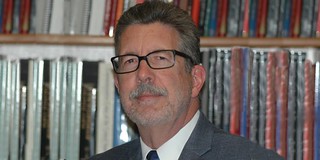 The Numismatic Literary Guild (www.NLGonline.org) Board of Directors unanimously approved the appointment of Ron Guth of San Diego, California to be the NLG Executive
Director starting September 1, 2018. He succeeds Donn Pearlman of Las Vegas, Nevada who agreed to serve in that role for a year following the August 2017 passing of long-time NLG
Executive Director Ed Reiter.
The Numismatic Literary Guild (www.NLGonline.org) Board of Directors unanimously approved the appointment of Ron Guth of San Diego, California to be the NLG Executive
Director starting September 1, 2018. He succeeds Donn Pearlman of Las Vegas, Nevada who agreed to serve in that role for a year following the August 2017 passing of long-time NLG
Executive Director Ed Reiter.
Guth is an award-winning author and researcher whose works include “Coin Collecting For Dummies”, “The 100 Greatest Women on Coins,” and the “Encyclopedia of United States Gold Coins 1795-1933” (co-authored with Jeff Garrett).
A Certified Public Accountant, Guth has expertise in U.S. and world coins, operates GermanCoins.com and is a former President of Professional Coin Grading Service and PCGSCoinFacts.com.
“For decades, the NLG has been the biggest supporter of numismatic writers, giving them the recognition they deserve for what is often a labor of love,” said Guth. “I look forward to continuing the NLG’s record of service and to preserve, build, and expand the NLG so that every numismatic writer will have the opportunity to hone their craft in a supportive environment.”
To read the complete article, see:
Numismatic Literary Guild Names Ron Guth Executive Director
(https://www.nlgonline.org/news/numismatic-literary-guild-names-ron-guth-executive-director/)
For more information on the Numismatic Literary Guild, see:
https://www.nlgonline.org/
For all of my photos of the event, see our Flickr album:
2018 ANA NLG Bash (https://www.flickr.com/photos/coinbooks/albums/72157670302250547)
To read the earlier E-Sylum article, see:
WAYNE'S NUMISMATIC DIARY: AUGUST 19, 2018: PART 2 : NLG Bash
(http://www.coinbooks.org/v21/esylum_v21n33a26.html)
THE BOOK BAZARRE
NEW BOOK: FAKE COIN BIBLE
The NLG award announcements made me aware of a book by Sebastian Wieschowski published earlier this year on counterfeits. Here's some more information about it. -Editor
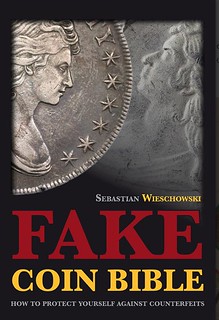 Fake Coin Bible: How to Protect Yourself Against Modern Counterfeits
Fake Coin Bible: How to Protect Yourself Against Modern Counterfeits
Coin fakes are not a new phenomenon, but they become more and more common in online auctions, classifieds portals and now even coin exchanges and auctions are literally flooded with counterfeit coins.
The imitations are made in Asia for a few dollars and end up in the hands of scammers, which will not be prosecuted in most cases.
And chipped collectors and investors are being left behind without any more confidence in a fascinating hobby – the long-term effects of coin counterfeiting are severe.
The book makes it clear that almost everything is forged – but collectors and investors can protect themselves effectively with a few tricks.
In meticulous and months-long work, german numismatic journalist Sebastian Wieschowski has collected a total of 111 coin forgeries for the “Fake Coin Bible”. The fakes were measured, weighed and documented with elaborate details. On each double page of the 268-page book, the counterfeits are compared with original coins. When reading the book, collectors and investors quickly get an idea of how counterfeits are easily revealed and which patterns can be observed on most fakes.
Decide for yourself which investment makes more sense: Hundreds or even thousands of dollars of damage through a bad buy – or a few euros for this good book.
The book contains a total of 111 examples of modern and historical coins. The focus is on historical world coins (especially the USA, the UK and Germany, but also Russia and China) as well as modern bullion coins (for example Panda, Koala, Kookaburra). In addition, the book provides well-founded background information on the most common counterfeits, the fraudulent machinations around the counterfeiters and the most important tips about counterfeit gold bars.
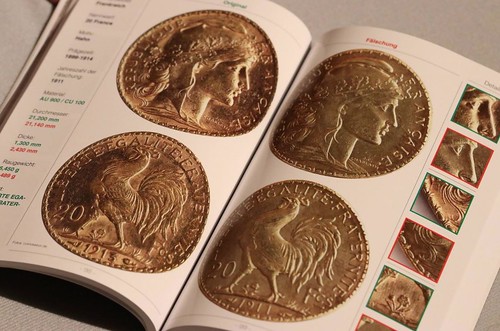
Key facts
- 268 pages
- A5 size
- high quality glossy paper
- full color
- soft cover
- 111 coins
- more than 500 photos
- XXL detail images of genuine and counterfeit coins
- more than 2500 pieces of data (thickness, diameter, raw weight, lettering)
- months of research
- founded background information
- retail price: earlybird subscription for around 20 USD including tracked worldwide shipping
For more information, or to order, see:
Fake Coin Bible: How to Protect Yourself Against Modern Counterfeits (https://bullionblog.de/fake-coin-bible/)
NEW BOOK: COINS MINTED BY THE KNIGHTS IN MALTA
Darren Burgess of Australia writes:
We just had our big numismatic weekend with the Melbourne Money Expo. At the show I got to meet John Gatt who's just published a new work on the Coins Minted by the Knights of Malta. It's a fantastic work and even though this isn't an area I collect a copy now graces my ever expanding bookshelves.
Thanks. Darren included the below link to the author's web site, from which I've taken the following information. -Editor
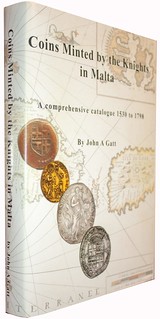 Coins Minted By The Knights in Malta
Coins Minted By The Knights in Malta
This book is a project of passion written by John Gatt that has taken twelve years and included hundreds of hours spent researching and photographing the coins of the Knights of Malta at museums and private collectors throughout the world.
The finest quality Hard bound book with 427 full colour pages with over 5,800 photos. The size, weight, rotation and edge type has been listed of over 2850 coin varieties which is close to twice the number listed in all previous catalogues. Images of all the coins are shown showing the difference with each variety.
The number of each variety found in museums and in private collections is shown giving an accurate indication of your coins rarity.
For more information, or to order, see:
Coins Minted By The Knights in Malta
(http://coinsofmalta.com/knights-of-malta-coins/coins-minted-by-the-knights-in-malta/)
The web site also helpfully lists several other useful books on the topic of the coins of the Knights of Malta. -Editor
To read the complete article, see:
Book on the coins of the Knights of Malta (http://coinsofmalta.com/Study/Books.htm)
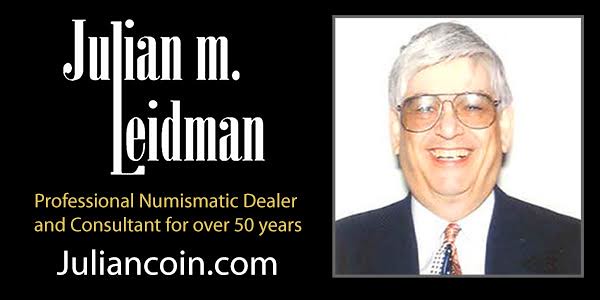
NEW BOOK: 2019 CATALOG OF WORLD COINS 2001-DATE
Krause Publications has released a new edition of the Standard Catalog of World Coins 2001-Date. -Editor
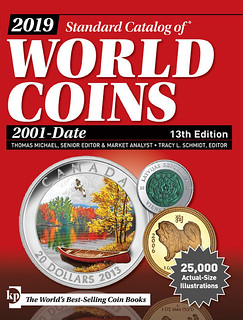 2019 Standard Catalog of World Coins,
2019 Standard Catalog of World Coins,
2001-Date, 13th Edition
Capturing the invaluable insight of 150 worldwide authorities, and the fantastic output of world Mints and Central Banks, the 2019 Standard Catalog of World Coins, 2001-Date, 13th edition, stands as the finest reference to the modern collectible coin market.
Creativity blends with tradition in today’s modern coin market, providing enthusiasts beautiful coins with inspiring and popular themes. Marrying creativity with usability, the Standard Catalog is arranged in alphabetical order by country and with groupings for political structure, coinage type and denomination, in an easy-to-follow format of coins representing the most innovative and ingenious design and execution in numismatic history.
Extensive yet easily managed, the catalog offers:
- More than 28,000 coin types
- Current values vetted by experts
- Global standard KM reference numbers
- Detailed description, weights and measures
"We compile information from many sources including internet auctions, live auctions, fixed price offerings, Central Bank, Mint and distributor websites, but we especially value our rich base of collectors, dealers and researchers all of whom contribute information they personally compile in the course of their hobby and business interactions.
The Standard Catalog of World Coins, 2001-Date is both an important catalog for those folks who collect and trade current circulating coinage, as well as for Mints, Central Banks and distributors who create and sell modern collectable precious metal coins. It is the one source where these two markets combine and provides the one reference to further the ends of both of these communities."
-Thomas Michael
Editor, Standard Catalog of World Coins
For more information, or to order, see:
2019 Standard Catalog of World Coins, 2001-Date, 13th Edition
(https://www.shopnumismaster.com/2019-std-cat-world-coins-2001-date-r7731)
NNP ADDS NATIONAL BANK CHARTER INFORMATION
The latest addition to the Newman Numismatic Portal is a set of spreadsheets of important data on U.S. National Bank banks, compiled from government records by Andrew Pollack. Great resource! Project Coordinator Len Augsburger provided the following report. Thanks. -Editor
U.S. National Bank Spreadsheets for Bank Charter Numbers 1-14348
From 1863 to 1935, the United States government chartered 14,348 National banks. These institutions deposited United States bonds with the federal Treasury, and in turn were allowed to circulate their own banknotes, up to 90% of the value of the bonds. These banknotes were backed by the federal government, and were eventually retired during the Depression with the introduction of Federal Reserve Notes. The result today is a cornucopia for paper money aficionados, with thousands of types and a host of themes to collect. Andrew W. Pollock III has created a massive series of spreadsheets capturing summary info for each of the federal charters, which may be downloaded in zip form via Internet Archive.

Illustrated here, from the Newman collection, is a $50 note from the First National Bank of East St. Louis (IL) in 1902. The note bears witness to its own solvency – “SECURED BY UNITED STATES BONDS DEPOSITED WITH THE TREASURER OF THE United States of America.” The bank charter number (#11596) is boldly printed twice on the face, and six times within the borders. Referring to the Pollock spreadsheets by charter number, we learn that the bank listed over $6m in assets in 1922 and had an issue of $400,000 in National Bank notes. The president and cashier of the bank were, respectively, A. C. Johnson and R. F. Reader. Pollock cites the Office of the Comptroller of the Currency report for 1922, which provides further breakdown of bank assets and liabilities.
Pollock notes he has been gathering material on U.S. national banks for over three years – given the copious detail in these spreadsheets, we are surprised it is only three years! Collectors and researchers of National Bank notes will find much useful data here, and we acknowledge Andrew W. Pollock III for sharing this information with the wider numismatic community.
Image: East St. Louis (IL) First National Bank $50 1902 Plain Back, Friedberg-683, PCGS EF40, Newman VIII (Heritage 11/2017), lot 28294, realized $2,160.
Link to National Bank Spreadsheets on Internet Archive:
https://archive.org/details/NationalBankSpreadsheetsGuide
Link to Office of the Comptroller of the Currency annual reports on Newman Portal:
https://nnp.wustl.edu/library/publisherdetail/510306
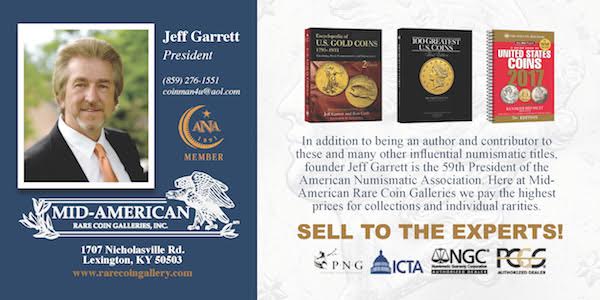
1892 COLUMBIAN EXPOSITION GLASS MEDAL
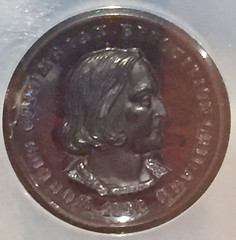
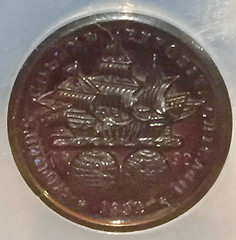
ANA Edition reader Pete Acampora writes:
I'm attaching photos of a glass "coin" I picked up late in 2017.
Pete caught the headline of the "Coins Made of Glass" article in an earlier issue, but that was about an artist crafting comtemporary alternative currency. Above and below are the images he sent. -Editor
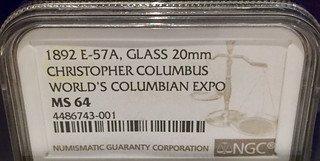
The "E-57A" number on the NGC slab is a reference to the Eglit work on Columbian Exposition tokens and medals. I've never seen one of these glass medals before. Would any of our readers have more information? Thanks. -Editor
To read the earlier E-Sylum article, see:
ART UNITS: COINS MADE OF GLASS (http://www.coinbooks.org/v21/esylum_v21n32a31.html)
DON BAILEY'S ORDER OF THE AZTEC EAGLE
Frank Draskovic is President of the Southern California Orders & Medals Society (SOCALOMS). He submitted this rememberance of Don Bailey. Thanks. -Editor
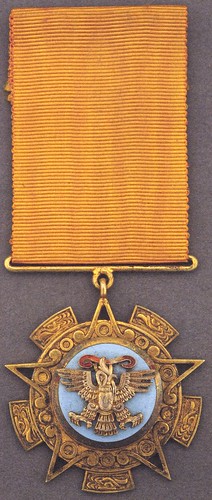 Earlier today when cataloging a Grand Cross breast star of the Mexican Order of the Aztec Eagle, I thought of Don Bailey's 2001 award of the "Insignia
Class" of this Order. That reminded me to phone him to say hello. Then a few hours later when I read the notice of his death, I was stunned.
Earlier today when cataloging a Grand Cross breast star of the Mexican Order of the Aztec Eagle, I thought of Don Bailey's 2001 award of the "Insignia
Class" of this Order. That reminded me to phone him to say hello. Then a few hours later when I read the notice of his death, I was stunned.
I visited Don and Lois shortly after he learned of his pending bestowal of the Order of the Aztec Eagle.
He didn't mention it at first, but while we chatted about Mexican Orders & Medals he nonchalantly handed me an envelope with the Mexican eagle embossed on the flap. What a surprise to see an invitation to his own award ceremony. Then he proudly beamed a wide grin as I read the details of his award. I was so happy for him, but couldn't attend due to family illness, yet I still treasure the invitation which I keep in the appropriate section of Grove's Vol. 3 on Mexican ODMs.
I will miss him as will all who knew him, truly a scholar and a gentleman. My condolences to Lois, his family and his many friends.
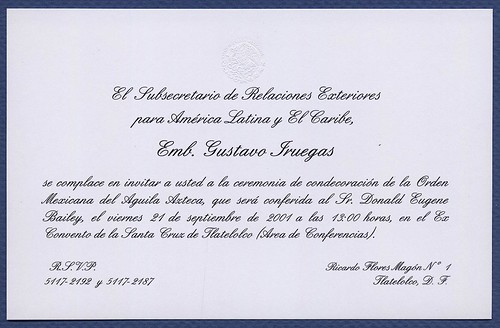
Medal image credit: Princeton University Numismatic Collection
To read the earlier E-Sylum article, see:
DON BAILEY (1933-2018) (http://www.coinbooks.org/v21/esylum_v21n33a11.html)

NOTES FROM E-SYLUM READERS: AUGUST 26, 2018
The Philadelphia WFOM and Reading Terminal Market
Dave Hirt writes:
Regarding your ANA diary - what a great write up. You must have been like a whirlwind. I have great memories of the Reading terminal market. What wonderful tastes there are there.
The show was definitely a blur for me - it all went by so fast. The Reading Market is a great feature of conventions in Philadelphia. For more information on the show (and links to last week's diary entries), see the article on 2018 World's Fair of Money exhibits elsewhere in this issue. -Editor
Reader Thanks
Peter Merani writes:
Thanks for The E-Sylum. I enjoy reading each edition. I never knew there was so much information available in the bibliomania area.
You're welcome! -Editor
On Coin Composition Testing
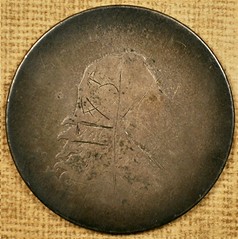
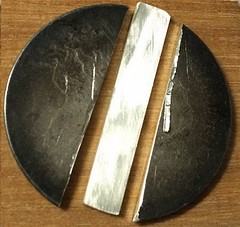
Tom DeLorey writes:
The metalurgical tests on the 1794 and 1795 half dollars are fascinating, even if a tad horrifying. I look forward to seeing the results, and I do hope that each piece was also tested non-destructively on its normal surface, for comparison with the test results of the naked interior. By seeing how close the two test results are, it should allow better specimens to be non-destructively tested in the future with a good idea of how accurate the non-destructive tests are!
Good points. Thanks. -Editor
To read the earlier E-Sylum article, see:
RESEARCHERS PUT EARLY SILVER COINS TO NEW TESTS (http://www.coinbooks.org/v21/esylum_v21n33a12.html)
Tin and U.S. Cent Compositions
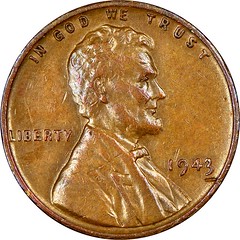 Last week's article on the discovery specimen of the 1943 bronze cent stated
Last week's article on the discovery specimen of the 1943 bronze cent stated
"All 1943 cents were supposed to have been struck on zinc-coated steel planchets to save precious copper for more critical wartime production needs. In prior years, cents were struck on planchets made of bronze (95% copper and 5% zinc)."
Chip Howell writes:
If I recall correctly, bronze requires tin, which the earlier alloy included (~2.5%) but shell-case cents did not. Thereafter, the pre-war alloy was resumed until 1962, when tin was removed, making them effectively brass (until 1982).
Good point. Thanks. -Editor
To read the earlier E-Sylum article, see:
DISCOVERY SPECIMEN 1943 BRONZE CENT GRADED (http://www.coinbooks.org/v21/esylum_v21n33a16.html)
On Coin Striking Pressures
Last week John Regitko asked about striking pressure for U.S. coins. -Editor
Dick Johnson writes:
Formerly U.S. Mint Reports carried data on striking pressures of all denominations.
The Newman Numismatic Portal has a great number of U.S. Mint reports available for reading and online searching. -Editor
Tom DeLorey writes:
Here is an article from Coin World on striking pressures. The Australian pressures sound about right. The Canadian pressures sound rather high, but that may have been because they were striking pure nickel 10 cent and up coins back then, and it is rather hard.
To read the complete article, see:
Tonnages used for striking numismatic versions of United
States coins and medals vary between diameters and compositions
(https://www.coinworld.com/news/us-coins/2014/04/striking-tonnages-for-numismatic-coins-and-medals-vary.all.html)
Thanks. -Editor
To read the earlier E-Sylum article, see:
NOTES FROM E-SYLUM READERS: AUGUST 19, 2018 : Query: Striking Pressure For U.S. Coins
(http://www.coinbooks.org/v21/esylum_v21n33a13.html)
Bosbyshell and the First Defenders Medal
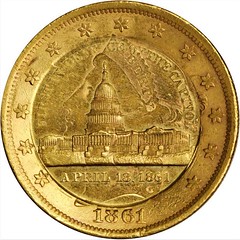 Dave Hirt writes:
Dave Hirt writes:
I want to comment on the Gold Pennsylvania First Defenders medal. I agree with what Gary wrote that Oliver Bosbyshell was involved. I have a book in my library, Pennsylvania at Antietam, published at the dedication of monuments, in 1906, to the Pennsylvania fighters of that battle. Colonel Oliver C. Bosbyshell was a member of the three man committee in charge of this task.
To read the earlier E-Sylum article, see:
ON THE PENNSYLVANIA FIRST DEFENDERS MEDAL (http://www.coinbooks.org/v21/esylum_v21n33a15.html)
Bolender 76th Sale PRL Sought
Mike Dlugosz writes:
I'm looking for a prices realized list for Milford Bolender's 76th auction held June 11, 1932. I didn't find it through the ANA, ANS (who have a copy of the catalog only), or on the Newman Numismatic Portal. I read in a past issue of The E-Sylum that David Perkins has been a collector of Bolender catalogs for quite sometime.
I checked with both Dave Perkins and Karl Moulton, and they don't have this PRL. Can anyone help? -Editor
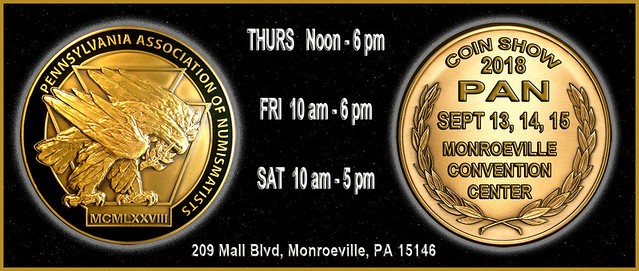
METAL-TYPER TOKENS
Last week David Pickup asked about a token picturing Niagara Falls. Several readers chimed in with responses. -Editor
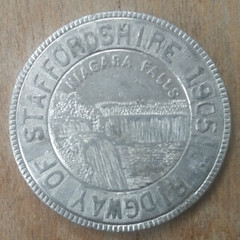
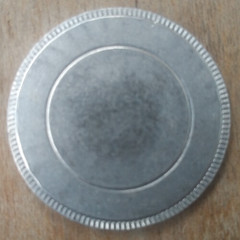
David Schenkman writes:
Regarding this piece, it is simply one of those do-it-yourself tokens that could be purchased from machines at various tourist spots. You put coins in a slot (I’d guess 50¢) and you could emboss whatever you wanted on an aluminum blank that often had a scene relating to the place. In this instance someone visited Niagara Falls and made themselves a personalized souvenir.
Tom DeLorey writes:
The Niagara Falls token was a souvenir piece hand made by a clunky machine that embosses letters one at a time on an aluminum disc. Such machines were commonly found at touristy areas, which Niagara Falls certainly is. The last time I was at the Penny Arcade in Manitou Springs, CO there was one of them in use.
You can put anything you want on the piece. Most people put their names on them; this might have been done by somebody named Ridgway from Staffordshire. The year 1905 may or may not be when it was made.
When I worked at Harlan Berk's I used to throw common ones purchased in collections in the 50 cent junk box. This one with the pictorial center is rather unusual and no doubt worth more. I probably would have placed it in the $3 token box, but what do I know?
Henk Groenendijk writes:
This token is a souvenir punch medal. These could be punched with a machine with 'ones name and address or indeed with any text one wished. So this is a US or Canadian medal stamped with such a machine probably by an Englishman! One type of machine used for this is the "Harvard Metal Typer Stamper". Googling this will bring up examples of both this machine and tokens stamped with it.

Metal-Typer Machine (image found by Oded Paz)
Exonumia Aficionado Oded Paz writes:
Regarding the Query: Niagara Falls on British Token, there is actually no connection between the two. The letters around the medal are punched into the token. The machines making them are called METAL-TYPER.
You can see such machines here: https://www.flickr.com/photos/anythreewords/galleries/72157627972843253
https://fineartamerica.com/featured/metal-typer-machine-susan-carella.html
And here are similar tokens that I found on eBay:
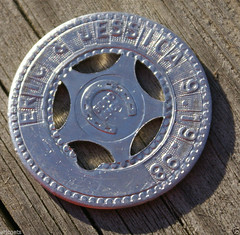 https://www.ebay.com/itm/Custom-Good-Luck-Metal-Typer-Coin-Token-Birthday-Fishermans-Wharf-SF-Ripleys-/222372069948
https://www.ebay.com/itm/Custom-Good-Luck-Metal-Typer-Coin-Token-Birthday-Fishermans-Wharf-SF-Ripleys-/222372069948
https://www.ebay.com/itm/NEW-YORK-1939-WORLDS-FAIR-SOUVENIR-ALUMINUM-STAMPED-TOKEN/273408728909
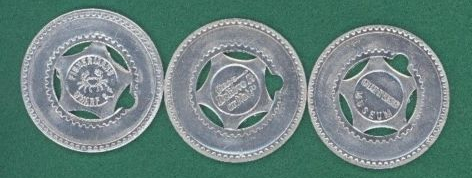
As you can clearly see, the area around the punched-in letters has the same texture, just like the token in the newsletter. I hope this clarifies the issue.
Thanks, everyone! Yes - looking at the obverse of David's token there are outlines around each of the letters. These are less obvious than on some of the other tokens Oded found, but definitely there. Interesting concept. Are any of these machines still in operation somewhere other than antique shops? Are there modern equivalents with 3-D printers? I could envision a machine that would produce a plastic souvenir with a custom slogan on it. -Editor
To read the earlier E-Sylum article, see:
NOTES FROM E-SYLUM READERS: AUGUST 19, 2018 : Query: Niagara Falls on British Token
(http://www.coinbooks.org/v21/esylum_v21n33a13.html)
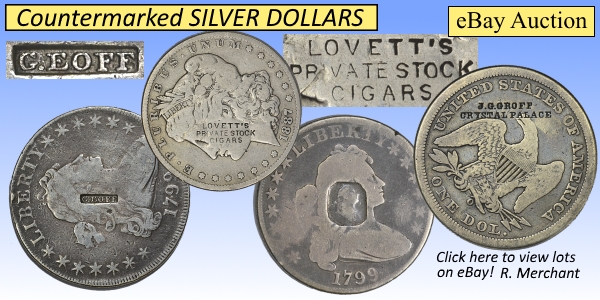
ELLIS AND READ PERPETUAL CALENDAR MEDALS
Tom Caldwell and Chris Clements run Northeast Numismatics in Concord, MA. I found a couple great pieces on their web site while working on this issue and added them to my Numismatic Nuggets article. Here's another great item - Chris submitted this write-up about a super Civil War piece. -Editor
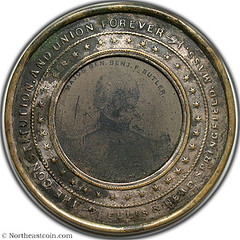
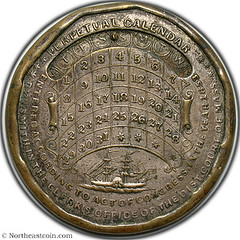
Our in-house variety specialist and intern, Ben Simpson, recently discovered an interesting item.
Benjamin found a perpetual calendar ferrotype located at the bottom of a grimy old box in Tom’s office. While it may not look very attractive or special, the medallion is a rare relic of Civil War era America, and highly collectible.
The silver plated brass medallion was manufactured by Ellis and Read of Springfield, Mass during the Civil War. It features an inlaid ferrotype of Major Gen. Benjamin Butler on the obverse, and a perpetual calendar on the reverse. The calendar can be used to determine what days of the week correspond to any date, past, present, or future.
Benjamin Butler, whose photograph is encased in this brass medallion, was a famous general, politician, and businessman of the 19th century. Born in 1818, Butler was a native of Lowell, Massachusetts. He studied to be a lawyer at Colby College and began a career in politics as a democrat after graduating. He entered the Lowell militia in 1840 and rose to the rank of colonel by the beginning of the Civil War. Butler was promoted to major general in 1861. He oversaw the 1862 Union occupation of New Orleans while simultaneously making himself a fortune by manufacturing war supplies in Lowell (Butler used his position in New Orleans to ensure that his textile factories got a steady supply of cotton). After the war, Butler was elected Governor of Massachusetts, and he unsuccessfully ran for president in 1884. Butler died in 1893.
Little is known about Ellis and Read of Springfield, who manufactured these political medallions during the civil war.
Several varieties of the Ellis and Read perpetual calendars are known to exist, including variants that feature ferrotypes of Abraham Lincoln, Ulysses S. Grant, George McClellan, and other prominent political figures of the time. They are all highly sought after by collectors and can sell for thousands at auction. There are no Benjamin Butler medallions known to exist, nor have they been listed in any catalog of American political exonumia. Therefore, we believe we have a unique discovery piece for the series of perpetual calendars. You never know what you will find by doing a little digging through Tom’s cluttered office!
To visit the Northeast Numismatics web site, see:
http://www.northeastcoin.com/
VOCABULARY TERM: SIGNATURE
Dick Johnson submitted this entry from his Encyclopedia of Coin and Medal Terminology. Thanks. -Editor

Signature. Any of a variety of ways the creator of a work of art signs that work. Signatures can be initials, monograms, symbols, a single name, or a signature in script. Artists have used such a variety of signatures, symbols and pseudonyms that art researchers and historians must use extreme diligence to identify the correct author of any given work of art. Signatures on coins are often the shortest of all, usually one, two or three initials.
Extreme limited space on coins and medals requires brevity, however full names have appeared on numismatic works. Published lists of initials and monograms revealing the original artist are required references for the person who must identify, describe or authenticate coins or medals. A numismatic item without a signature is UNSIGNED (even though the creator may be identified by research). The item is called ANONYMOUS when it is unsigned and no amount of research reveals the artist.
Because a signature is so much a design element, the artist often renders it in an artistic way. An elaborate MONOGRAM is occasionally created (possibly obscuring the sequence of the letters, or the most prominent letter by intertwining of the initial letters). One artist, Augustus St-Gaudens, created a different monogram for nearly every work of art; while a charming mannerism, this trait requires more diligence necessary for the art historian.
Signature locations. Signatures on coins and medals are always found in the lowest part of the design, usually to the right. This is like signing a document or letter at the bottom right; this similar position is predominantly chosen for paintings, prints, other works of art.
For those coin and medal designs with an EXERGUE, the signature can often be found on the side of the listel (a bar across the base line), slightly below, or on top of the listel. Also for those portraits of a bust, the signature is occasionally found on the TRUNCATION of some part of the bust.
Signature abbreviations. Signatures sometimes contain arcane letters following the name or initials on medals. These reveal what part the signer had in the creation of that medallic item. Once these abbreviations are learned an entire division of labor is sometimes revealed. The most encountered is FECIT, a Latin word (pronounced FEE-set) meaning he (or she) did it, or made it, or created it, or engraved it. The letters F or FEC after a name or initials indicates this Latin term. It is used in medallic art more often than any other signature form.
The letter D or DES is the designer of the item; DEL is the delineator, the person who creates the concept, expressing it with a rough drawing. If D alone has been used as an abbreviation for either of these it obscures the true meaning. Also the abbreviation edit is for the French word editeur; it is not the editor as we know it in English, but instead the publisher or issuer of the piece.
Signature confusion. Problems also arise when two or more artists used the same initials. There are, for example, four J.R.s, two Americans and two British. There are eight C.W.s. For single initials signatures, the problem increases; there are 48 artists listed in Forrer who have signed H, and 36 who signed W. It becomes necessary to know who was working in what geographical area in what specific time period. Even a somewhat limited series of medals like the Society of Medallists in America has two medals signed exactly the same by two different artists (number 14 by Albert Stewart, and number 114 by Alex Shagin), both obviously signed “AS.”
Monograms compound the problem. First it is often unclear in the sequence of letters once they are deciphered from intertwining. Also monograms of artists are often confused with those of the medallic firm that made it, or with a client’s or issuer’s monogram. Even the registration, copyright or trademark symbols required by law in some countries add to the confusion.
Sales agents and importers sometimes have their initials or monograms placed on medallic items. For a period in the 1960s Nebraska Numismatics imported European mint medals and had their logo of a double N placed on those imported. And the FK initials of another importer -- F. Knight of New York -- appeared on the John Philip Sousa Centennial Medal he brought to America in 1954.
Artists who have collaborated on a medal infrequently have created a new monogram incorporating both last name initials. Mario Cooper and Robert Foster did this for a CF monogram on the Society of Illustrators Medal of 1950.
Women artists who take their husband’s name after marriage may change their monogram. Anna Vaughn Hyatt who married Archer Milton Huntington used both AVH and AHH monograms in her lifetime.
For some unknown reason sculptor Gifford MacGregor Proctor placed a symbol – what looks like two birds in flight – in a location normally reserved for signatures, under the device on the reverse slightly to the right on the Aldo Leopold Medal of 1951.
Finally, the world of numismatics abounds with unidentified initials, monograms and symbols. We may never learn who was he creator of objects signed by these carefree artists.
Family signatures. Other areas of confusion are the dynasties of engravers or firms extending over several generations, all members of which signed a similar name, initials or monogram. The most famous of these are the Wyon family of English engravers, medallists, diesinkers and sculptors, 15 of which created coins and medals.
In Belgium there were two Weiners. In Germany two Mayers. In France three or more medallists existed in each of the Barre, Dubois, Dupre and Yencesse families. The Lovetts in America extended over three generations and 80 years of token and medal making; there were five engravers, a father, three sons and a grandson. Many other examples could be listed.
Hidden signatures. While signatures are hidden in the design of paper money engravings far more often than in medallic items, these instances do exist. The most interesting example is a medal for a Columbian anniversary activity, the New York Municipal Columbian Entertainment Committee Badge of 1893. The uniface medal was engraved by Victor David Brenner. He had just been employed by the medallic firm of Robt. Stoll in New York City.
Brenner signed the piece in the grass below the city seal – but backwards! (Actually he signed it in the die he had just cut intaglio, but signed it cameo – right to left – so when it strikes a piece it appears with lettering left to right.) Since the lettering is hidden in the grass, it is not obvious upon first inspection. Whether this was done surreptitiously, or with his new employer’s permission is, of course, not recorded. But the piece is charming.
Signature charm. If a large number of signatures are examined it will be noted some artists are quite adapt at signing their works of art in charming ways. John Flanagan placed his JF initials in the O of the obverse legend on the Panama-Pacific International Exposition Medal of Honor in 1915. Look for the JF in the center of the last O of HOMO in the Latin phrase: DIVINE DISIVCTA IVNXIT HOMO.
Anthony de Francisci underlined his initials with a sculptors burnisher on the United Parcel Service 50th Anniversary Medal, 1957.
Carl Paul Jennewein placed a tiny self-portrait character and date in his 1933 issue of the Society of Medallists (Issue number 7).
A husband and wife team have all their initials on a center letter. Holger and Helen Webster Jensen have a J monogram with an H on one side for him, and H and W on the other side for her. It appeared on the North American Aviation Dedication Medallion, of 1964.
The Frasers – James Earle and Laura Gardin – did the same for both a coin and medal for the Oregon Trail Memorial Half Dollar of 1926 and the Oregon Trail Medal of 1929. The husband and wife team, both accomplished medallists, collaborated together medallically for these two commissions.
Marcel Jovine created a bilingual medal for the Apollo Souyez. Obverse was in English and showed the American Apollo capsule; the reverse was the Russian spacecraft with legend in Russian. He signed both sides; in English on the obverse, in Russian on the reverse.
But, perhaps the most charming of all is a concordant medal (the reverse is the back of the obverse as if the medal was sculpture in-the-round). In 1937 sculptor Robert
Ingersoll Aitken did a medallic tribute to Love; he showed a couple embracing front and back. He signed the piece on the reverse in reverse. Within an oval he has the six letters
of his last name in groups of two – backwards. Charming! The medal was the 15th Issue of the Society of Medallists.
CLASS 03.6
References:
E3 {1902-30} Forrer.
S20 {2010} Johnson.
Note: This is a shortened version of the Signature entry. The complete entry appears on the internet at Newman Portal. Click on Dictionary, then S and Signature.
An extensive list of 465 American signatures – and a 25-page text on signatures – appears in the author’s book Monograms of American Coin and Medal Artists, available from the author for $35 postpaid: Dick Johnson, 139 Thompson Drive, Torrington, CT 06790. Checks only please.
For more information on Dick's Monograms book, see: NEW BOOK: MONOGRAMS OF AMERICAN COIN AND MEDAL ARTISTS (http://www.coinbooks.org/esylum_v13n32a04.html)
Looking for the meaning of a numismatic word, or the description of a term? Try the Newman Numismatic Portal's Numismatic Dictionary at: https://nnp.wustl.edu/library/dictionary
Or if you would like a printed copy of the complete Encyclopedia, it is available. There are 1,854 terms, on 678 pages, in The Encyclopedia of Coin and Medal Technology. Even running two a week would require more than 19 years to publish them all. If you would like an advance draft of this vital reference work it may be obtained from the author for your check of $50 sent postpaid. Dick Johnson, 139 Thompson Drive, Torrington, CT 06790.

LEWIS GRAUER (1854-1918)
Samuel Grauer (1814-1892), was born on May 23, 1814 at Roudnice, Czech Republic, son of Jewish parents Abraham Grauer, and Ludmilla Grauer.
In 1845, he moved to Baltimore when he was 31 years old working as a tobacconist and cigar manufacturer.
He lived at 646 West Baltimore Street, Baltimore, Maryland.
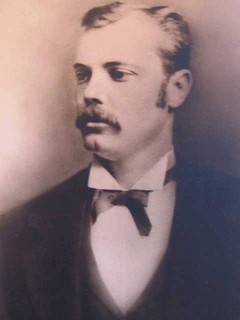 He married Hannah "Anna" Grauer. They had a son Lewis (1854-1918). His name is variably spelled either Lewis or Louis. He was born on December 28, 1854 at
Baltimore, Maryland.
He married Hannah "Anna" Grauer. They had a son Lewis (1854-1918). His name is variably spelled either Lewis or Louis. He was born on December 28, 1854 at
Baltimore, Maryland.
The tobacconist firm of S. Grauer & Son, 170 West Pratt Street, Baltimore, Maryland was dissolved on December 10, 1881. Lewis Grauer became the sole proprietor continuing under
the name of the firm S. Grauer & Son. Two days following the dissolution Captain John White Haseltine sold Lewis' coin and stamp collection in his 36th coin auction sale,
which he had previously acquired, selling the whole of it at Bangs & Company, New York.
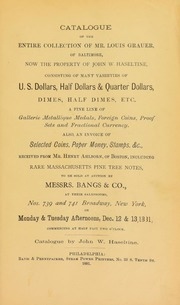 "December 12 and 13 Mr. Haseltine sold at the same place the collection of Mr. Louis Grauer of Baltimore, consisting of many "varieties" of United States
Coinage, a line of Gallerie Metallique Medals, together with proof sets, paper money, stamps, and some rare Massachusetts Pine-tree Notes. The Catalogue 40 pages, had 1352 lots. A
Dollar of 1801 sold for $6.75; do. 1836, flying eagle, v. g. 7.20; Dime of 1802. v. f. 22; Cent 1799 over '98, 13.25; Tin Medal of 1787, v. f. and r. size 27, obv. two ships,
Columbia and Washington, etc.. rev. "fitted at Boston N. America for the Pacific Ocean, etc.," 6.13; six Pine-tree notes, 1766 to 1799, sold from 3.80 to 6.00
each." American Journal of Numismatics, January (1882) : 69
"December 12 and 13 Mr. Haseltine sold at the same place the collection of Mr. Louis Grauer of Baltimore, consisting of many "varieties" of United States
Coinage, a line of Gallerie Metallique Medals, together with proof sets, paper money, stamps, and some rare Massachusetts Pine-tree Notes. The Catalogue 40 pages, had 1352 lots. A
Dollar of 1801 sold for $6.75; do. 1836, flying eagle, v. g. 7.20; Dime of 1802. v. f. 22; Cent 1799 over '98, 13.25; Tin Medal of 1787, v. f. and r. size 27, obv. two ships,
Columbia and Washington, etc.. rev. "fitted at Boston N. America for the Pacific Ocean, etc.," 6.13; six Pine-tree notes, 1766 to 1799, sold from 3.80 to 6.00
each." American Journal of Numismatics, January (1882) : 69
The 1799/8, S.188, was in fine condition. See Walter Breen's Encyclopedia of United States Large Cents : 540-542 (Grauer/Haseltine specimen not cited). David Lawrence, September 2017, Sale #978, lot 2009, NGC/CAC F-12 BN sold for $23,000.
Lewis died at Merion, Montgomery County, Pennsylvania, on March 22, 1918. He is buried at West Laurel Hill Cemetery, Bala Cynwyd, Montgomery County, Pennsylvania.
To read the complete article, see:
GRAUER, LEWIS
(https://sites.google.com/a/numismaticmall.com/www/numismaticmall-com/grauer-samuel)
Nice collection. See the full catalog on the Newman Numismatic Portal. -Editor
To read the complete catalog, see:
Catalogue of the entire collection of Mr. Louis Grauer of Baltimore, now the property of John
W. Haseltine ... (https://nnp.wustl.edu/library/auctionlots?AucCoId=510907&AuctionId=511617)
The entire inventory of the Lupia Numismatic Library is for sale. Individual items will be available before the remaining archives are broken up into parcels sold at philatelic auctions in the U. S. and Hong Kong. Check NumismaticMall.com frequently as dozens of new items with estimates will be posted daily until everything is sold.
All inquiries will be given prompt and courteous attention. Write to: john@numismaticmall.com .

HARVEY STACK'S NUMISMATIC FAMILY, PARTS 23-25
Harvey Stack's Stack's Bowers blog series focuses on growing up in a numismatic family. Here are parts 23-25. Nothing beats a report on numismatic events and personalities direct from someone who was there to witness them in person. Thanks, Harvey! -Editor
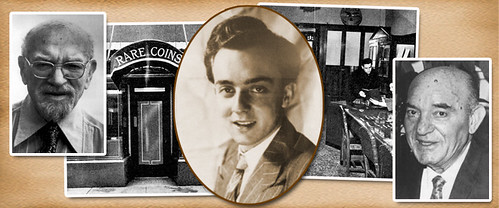
Part 23: 1955-1956
Stack's continued to hold auctions, including at conventions for the Metropolitan New York Numismatic Association as well as the New England Numismatic Association. Of mention
were several major collections such as the Lenox Lohr Collection of U.S. Coins featuring Proof coins, as well as many type coins. We also sold the B. Frank Collection, which was
highlighted by an 1876-CC twenty-cent piece, (the first to be available for years). An interesting thing happened at the end of that sale. John J. Ford, Jr. came up to me and
said, "You guys had a number of bidders on the 1876-CC twenty cents. Could you place one or two more?" We said we would try. John then took out of his pocket five
examples! Each member of the Stack family took one, and we offered them to the underbidders who were still in the room. We were able to place all five during the post-sale period.
This was one of many interesting experiences I had with John Ford over the many decades we knew each other, both as friendly competitors and working together. This encounter was
just another part of my "growing up."
As I mentioned last week, we offered the Farish Baldenhofer Collection, which was one of the collections I helped build. Many of his coins are proudly referred to today as classic examples of U.S. series. I had met the consignor at a show in 1949. We became friends, and when he decided to sell I was able to make the auction contract with him. This collection started with colonials and continued right up to the 1932 $20 gold double eagle, with many rarities along the way. Though not complete it was quite comprehensive, and it also had the 1884 and 1885 trade dollars. As with so many of the old time holdings that Stack's sold in the 1950s, the coins became part of many fine collections.
During the years 1955 and 1956 Stack's retail business expanded, and I learned a great deal from clients and collectors who visited us in our New York store. These visitors were very enthusiastic and happy to share knowledge back and forth with those of us who worked in the store, as well as with the other numismatists who gathered there. Developing and nurturing collectors, both new and old, was our most important goal.
Stack's used to host a group of young collectors from the Pingry School in New Jersey who would make field trips to New York to acquire coins for their collections. It was a pleasure to watch them select their new additions, and to talk about coins to those of us who were behind the counters. Some only had a small amount to spend, and would do some chores for us, like sorting coins, putting them into 2 x 2 envelopes, etc. It was fun and exciting to see this generation learn and grow into good numismatists. To this day we serve some of the graduates of that school many of whom are now advanced collectors. Dealing with the youth was a great learning experience that I will always remember.
During 1955 and 1956 we were able to obtain addition rare and unusual gold coins to add to the Josiah K. Lilly Collection. We acquired more doubloons, coins of England and France, early dates of Spain and the German States, as well as a number of coins from Scandinavia, the Far East, and the Ancient World.
We also continued to pursue the $20 gold collection of Robert Schermerhorn of Dallas, Texas, which had been promised to us when he was ready to sell his collection. In the spring of 1956 Bob called and said he was ready to sell, if possibly privately. We negotiated a price and then J.K. Lilly bought it.
Though not absolutely complete, it was an outstanding array of coins, mostly in Mint State and Proof, with but a dozen or so still missing. Mr. Lilly was pleased and told us to go out and "fill the missing holes," which of course we did. When I would deliver his new purchases to him in Indianapolis he always discussed his collection, and the desire to improve on it. At one of those meetings we discussed United States Pioneer and Territorial gold coins, one series I was very fond of and had extensively researched. He decided to build a collection of this rare and very historical series, from the $l gold Bechtler coins to the $50 California "slugs." This was a great opportunity for me to immerse myself in a series that I loved, as I felt the monetary history of the growth of the United States was so closely tied to these coins.
As you can see, being able to work directly on a major collections and continuing my research moved me from a basic dealer to an advanced numismatist. I helped build new collections, worked with developing collectors, had direct contact with specialists in most series, and expanded my abilities in the hobby. Working in the store, preparing auctions, and meeting other numismatists provided experience that I could not have obtained anywhere else.
I was very lucky to grow up in this learning environment, a model that the Stack family adopted and encouraged. It would be hard to find the same situation now. Today I enjoy passing on what I have earned and hope to encourage others to dedicate themselves to numismatics, as I did.
Part 23: 1957
By 1957 I had about 10 years of experience, full time, at Stack's which exposed me to an active retail trade in coins, dynamic public auctions and vibrant mail bid sales. In
addition, I had experienced meeting clients from yesteryear as well as those currently building or selling their collections. I had learned much about the art of auction
cataloging and price list presentation and along the way greatly expanded my numismatic expertise. All of these things, along with the help and encouragement of the very good
professional staff at Stack’s, greatly enhanced my skills as a professional numismatist. This exposure, provided by our shop in the heart of New York City, gave me the benefits of
a numismatic culture that would be hard to find in the 21st century.
I also attended many coin shows nationwide, and even went to Europe for some sales. I was trained in all series, from Ancient coins to items of the modern era, covering all metals and currency that were actively collected.
Starting about 1957 there was a new direction and interest in the coin collecting hobby. The earlier years of this decade, while having some momentum driven by collectors, seemed dominated by speculators buying late date Proof sets, 1936-1942, and 1950 to 1957, as well as full Mint State rolls of current issues, thinking these would grow significantly in value. That bubble started to burst around 1957 and the prices of these items dropped. This had an adverse effect even on earlier United States coins. From 1950 to 1957 the number of Proof sets struck at the Mint went from 50,000 to over 2,200,000. The Mint sold these sets at $2.10 each, and they were grabbed up by speculators as the "way to make money." Unfortunately, the number of collectors in the country who wanted Proof sets for their collections never reach that number and so all those that were put away were not placed in individual collections. There was never enough demand to make these sets sustain the speculation.
However, at the same time, collectors who had started their collections prior to World War II returned to collecting and bought more classic issues. In addition, new collectors began collecting coins from change, housing them simply in low cost albums. These beginning numismatists then expanded to rarer coins, and also encouraged their children to take up the hobby.
Adding to this portion of the market was the availability of collections built before World War II, brought about as those collectors either passed away or lost interest in maintaining their collections. Many of these were sold outright to dealers or were sold for the client at public auction. So, returning and new collectors had "fresh coins" to add to their cabinets. In this way, the hobby turned back to collecting, while it backed away from the speculative fever of the earlier 1950s.
During this period we served many dedicated collectors and helped them grow their collections with desirable coins. In addition we had the pleasure of helping beginning collectors who became interested in the hobby. Through our store we attracted many great collectors, some of whom are now numismatic legends. We worked on historic collections including the Louis E. Eliasberg Collection (improving the grades of some of his coins), and the various Josiah K. Lilly coin collections. We were busy, almost every day and night working with collectors and preparing auction catalogs, while still acquiring and stocking coins for sale over the counter. 1957 was also an important year for auctions, as I will discuss in my next article.
Part 23: 1957 Auctions
We began the year of 1957 with the J.W. Schmandt Collection, which had numerous rarities including Kellogg and Wass Molitor $50 slugs,(the two round coins of California Pioneer
days), a $4 Stella (Coiled Hair), 1796 and 1808 quarter eagles, 1933 $10 gold, a run of rare date double eagles including 1926-S and D, 1927-S and D, 1930-S, 1931-D and 1932.
Plus, there was an extensive offering of earlier silver and copper.
Among the other auction offerings were the D.H, Smith Collection and the Empire Collection (the collector C.A. Cass didn't want his name) that had been started by this gentleman’s family in 1885, and featured a very choice 1792 half disme, an 1894-S dime, an 1876-CC 20-cent piece, 1838-O, 1847/6, and 1853-O No Arrows half dollars and a choice 1794 $1. It also included virtually a complete set of dates and mints from 1793 to 1956 in Proof and Mint State condition. It provided another outstanding pedigree collection. These sales attracted many collectors and dealers from all over the country.
I am sometimes asked why some sales were give names other than the name of the person who assembled the collections. The reason is simple: some people wanted to collect privately and enjoy the hobby quietly. They did not want notoriety or open themselves up to be hounded for loans. We abided by their wishes and used "nom de plumes " in order to protect the owners’ real identities.
The year 1957 was marred by one factor that caused some disruption in gold coin collecting. A number of years before, counterfeits appeared in the marketplace, as coins which were considered "charms" became very popular and oversea counterfeiters started to flood the market with lower cost gold coins, made overseas and shipped here. In the beginning when these coins appeared in jewelry stores, pawn shops and even coin dealer show cases, the Secret Service tried and did apprehend a number of distributors and their customers. But the overseas imports became overwhelming. Dealers like Stack's who could readily detect these counterfeits helped identify the false coins which the agents brought to us to help them make their cases. Many were caught, indicted and tried in Federal court. The professional dealers acted as expert witnesses to help convict the owners and importers. We thought for sure that our efforts would stop those who imported these counterfeits, but there were too few agents and too many abusers. This went on for a number of years. It was important for us to help stop these importers, as we wanted to be able to provide greater assurance to our clients. Our business in gold continued to grow.
To read the earlier E-Sylum article, see:
HARVEY STACK'S NUMISMATIC FAMILY, PARTS 20-22 (http://www.coinbooks.org/v21/esylum_v21n28a18.html)
THE BOOK BAZARRE
STEPHEN ALBUM AUCTION 32 HIGHLIGHTS
Here's the press release with highlights from the September 13-14, 2018 auction from Stephen Album Rare Coins, specialists in Islamic, Indian & Oriental coins. -Editor
Stephen Album Rare Coins will hold its Auction 32 on September 13-14, 2018 at its offices in Santa Rosa, California. The auction is comprised of 2,200 lots of Ancient, Islamic, Chinese, General World, and Indian Coins, as well as Numismatic Literature. A significant portion of the sale is made up of general World Coins, of which there are 893 lots. Of particular note this time are a number of high grade Chinese dollars, a Jahangir portrait mohur, the Don Erickson Collection of German Coins (Part II) and the Hazerfans Collection of Ottoman Empire Coins. Additionally there is a large grouping of ever-popular Fatimid coins from an anonymous collection, as well as a grouping of coins from Sind & Multan that are historically significant and will surely attract specialized collectors.
Some highlights from the sale follow:
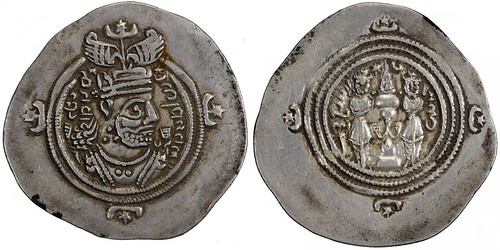
LOT 141: SASANIAN KINGDOM: Queen Azarmidokht, 631, AR drachm (3.98g), WYHC (the Treasure mint), year one, Sunrise-1007, Mochiri-505/10, the rarest of the Sasanian rulers, VF-EF, RRR Estimated at $8,500 to $10,500
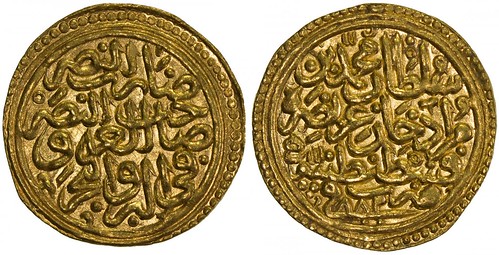
LOT 408: OTTOMAN EMPIRE: Mehmet II, 1451-1481, AV sultani (3.54g), Kostantiniye, AH882, A-1306, superb bold strike, choice AU, RR, ex Hazerfans Collection Estimated at $4,000 - 5,000
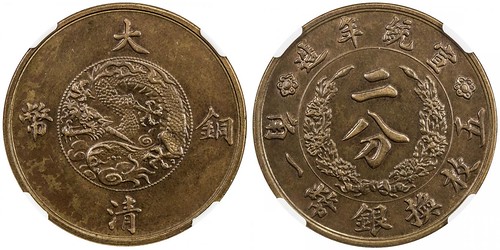
LOT 727: CHINA: Hsuan Tung, 1909-1911, AE 2 fen, ND (1910), Hsu-36, KM-Pn279., CCC-630, Duan-2487, pattern struck at the Vienna mint, lovely smooth chocolate patina, NGC graded MS63 BR+, RR Estimated at $10,000 to $15,000
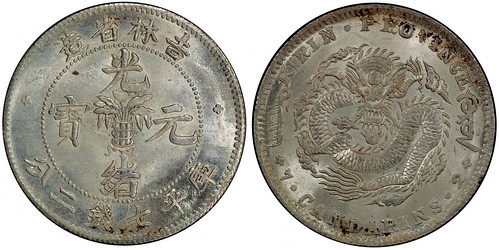
LOT 751: KIRIN: Kuang Hsu, 1875-1908, AR dollar, ND (1898), Y-183, L&M-515, Kann-287, branched horns type, brilliant white original luster, the finest known graded example, PCGS graded MS64. This coin is featured on the front cover of this auction catalog! Estimated at $10,000 to $15,000
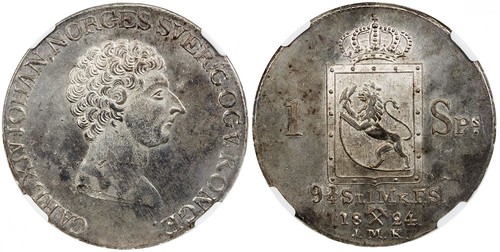
LOT 1363: NORWAY: Carl XIV John, 1818-1844, AR speciedaler, 1824, KM-290, mintmaster JMK, superb strike with wonderful reflective toned luster! NGC graded MS62 Estimated at $6,000 - 8,000
LOT 1414: EUROPE: COMPLETE COLLECTION of 410 dated coins, complete for every year from 1500 to 1899 -- a remarkable achievement; ten of the dates have duplicate coins. The collection consists primarily of European states and countries, with about 10 pieces of Spanish America and another 20 of post-independence Latin America of the 19th century; retail value of over $30,000, collection of 410 items Estimated at $22,000 - 28,000
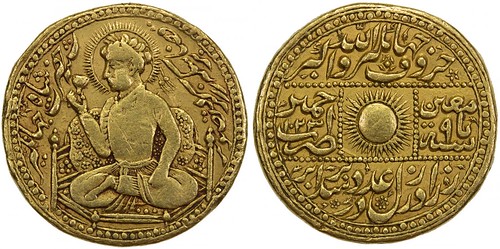
LOT 1866: MUGHAL: Jahangir, 1605-1628, AV portrait mohur (10.80g), Ajmer (Ajmir), AH1023 year 9, KM-197.6, magnificent design and calligraphy, same dies as #319 of the British Museum (published by Lane-Poole in 1892), and far superior to another example from the same dies, but only good fine condition, that sold in the Triton Auction XIX, Lot 2398, for $350,000, NGC graded AU55 Estimated at $220,000 - 260,000
The firm is presently inviting consignments for its Auction 33 which will be held on January 17-19, 2019, and will present lots for viewing at the NYINC convention in New York the week prior.
More information can be found on their website at:
www.stevealbum.com
For bidding, go to:
http://www.sarc.auction/

SELECTIONS FROM THE HOLABIRD 2018 NCTA SALE
Here's a selection of items that caught my eye in the upcoming August 31, 2018 Holabird sale for the National Token Collectors Association. -Editor
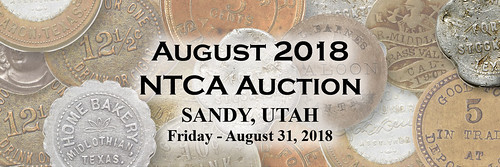
Lot 167: Randsburg District Fire Co. Token
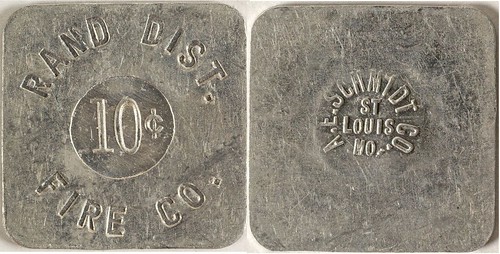
Obv.: Rand Dist. / 10c / Fire Co.; Rev.: A.E. Schmidt Co. / St, / Louis / Mo. Al., Sq. 23 mm. Daniel Manasselian Collection. State: California City: Randsburg Date: ID# 77759
Interesting St. Louis item. -Editor
To read the complete lot description, see:
Randsburg District Fire Co. Token
(https://holabirdamericana.liveauctiongroup.com/Randsburg-District-Fire-Co-Token_i30985816)
Lot 169: Rio Consumnes Correctional Center Token

Very rare, K 1, only three or four reported. Obv.: Rio / Cosumnes / Correctional / Center. Rev.: blank. Wm, rd., 15 mm. State: California City: Rio Consumnes Date: ID# 77767
Prison tokens are cool, no? -Editor
To read the complete lot description, see:
Rio Consumnes Correctional Center Token
(https://holabirdamericana.liveauctiongroup.com/Rio-Consumnes-Correctional-Center-Token_i30985818)
Lot 195: Lucas Secret Service Token
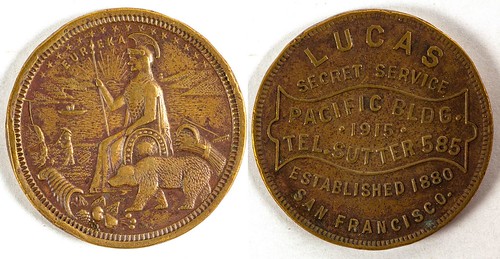
Obv.: Lucas / Secret Service / Pacific Bldg. / 1915 / Tel. Sutter 585 / Established 1880 / San Francisco; Rev.: pictorial of California State Seal. Br., rd., 34 mm. Daniel Manasselian Collection. State: California City: San Francisco Date: ID# 76879
What was this business? Private investigator? -Editor
To read the complete lot description, see:
Lucas Secret Service Token
(https://holabirdamericana.liveauctiongroup.com/Lucas-Secret-Service-Token_i30985844)
Lot 231: High Relief National Guard Medal
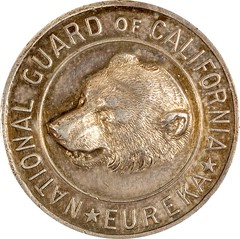
White medal with bezel, 28 mm. Obv.: National Guard of California / Eureka / (pictorial high relief grizzly bear); Rev.: Awarded / By The / State / 7422. State: California City: Date: ID# 78508
To read the complete lot description, see:
High Relief National Guard Medal
(https://holabirdamericana.liveauctiongroup.com/High-Relief-National-Guard-Medal_i30985880)
Lot 407: Crown Saloon Token
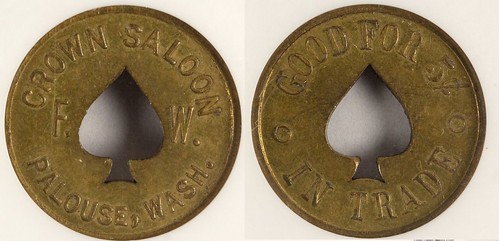
NGC MS 64. Obv.: Crown Saloon / F. W. / Palouse, Wash. Rev.: Good For / 5c / In Trade. Br., rd., spade cutout. State: Washington City: Palouse Date: ID# 77733
I like the unusual spade-shaped hole. -Editor
To read the complete lot description, see:
Crown Saloon Token
(https://holabirdamericana.liveauctiongroup.com/Crown-Saloon-Token_i30986056)
SELECTIONS FROM THE RAY BENTLEY COLLECTION
Here are some medals from the Ray Bentley Collection that caught my eye in the upcoming Morphy Auctions August 29-30, 2018 sale. -Editor
Jeannette Arctic Expedition Congressional Medal
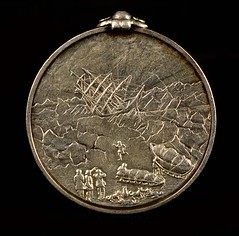
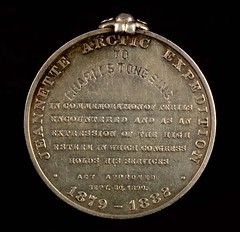
The round silver medal showing a three mast ship with the sails rolled and anchored to the ice, a group of men, dogs and dog sleds depicting the abandonment of the ship and the saving of some of its supplies. The reverse has an outer band reading "Jeannette Arctic Expedition 1879-1882" below this at the top center is engraved "To Charles Tong Sing". The bottom half "In Commemoration of Perils Encountered and as an Expression of the High Esteem in which Congress Holds His Services. Act Approved Sept. 30. 1890." The top bar and ribbon are missing but medal still retains the clasp that would have held it.
Note: This medal was produced for either the survivors or the next of kin of those who had perished in the expedition. Eight gold and 25 silver medals were struck by the Philadelphia Mint and were probably designed by Charles E. Barber or George Morgan, chief engravers to the mint. The story of the expedition was recounted in an 1882 book "Arctic Lost Ship Shipwreck Jeannette". The account of the expedition and its survivors caught the attention of the American public and caused Congress to act with this medal.
See the lot description for the fascinating history of this event. -Editor
To read the complete lot description, see:
Extremely Rare Silver Congressional Medal for Survivor "Charles
Tong Sing" of the "Jeannette" Arctic Expedition of 1879-1882. (http://auctions.morphyauctions.com/Extremely_Rare_
Silver_Congressional_Medal_for_Surv-LOT289711.aspx)
Life Saving Benevolent Association of New York Medals

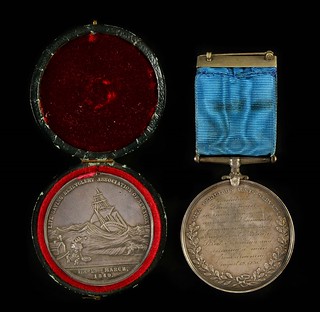
Two life saving medals awarded to Philip Rogers for rescuing people from the east river in Brooklyn in 1896 and 1898. From the Ray Bentley Collection.
Condition: (Very Good - Excellent).
Item Dimensions: Each: 2 - 1/2"
To read the complete lot description, see:
Lot Of 2: Sterling New York City Medals.
(http://auctions.morphyauctions.com/Lot_Of_2__Sterling_
New_York_City_Medals_-LOT291816.aspx)
New York City Fire Department Medal Of Valor
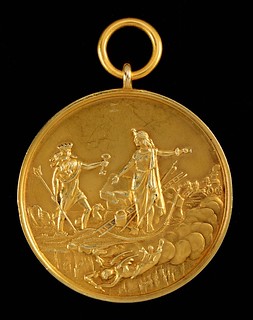
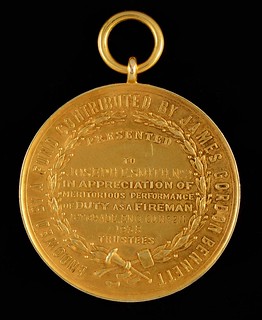
14K gold medal. The James Gordon Bennett medal is the highest honor that can be awarded to a New York City firefighter. This one was awarded to Joseph E. Smith in 1935. Made by Tiffany. 20 dwt. From the Ray Bentley Collection.
Condition: (Very Good - Excellent).
Item Dimensions: 1 - 1/2" dia.
I was unaware of the existence of these medals. -Editor
To read the complete lot description, see:
Rare 14K Gold FDNY Medal Of Valor.
(http://auctions.morphyauctions.com/Rare_14K_Gold_
FDNY_Medal_Of_Valor__-LOT291059.aspx)
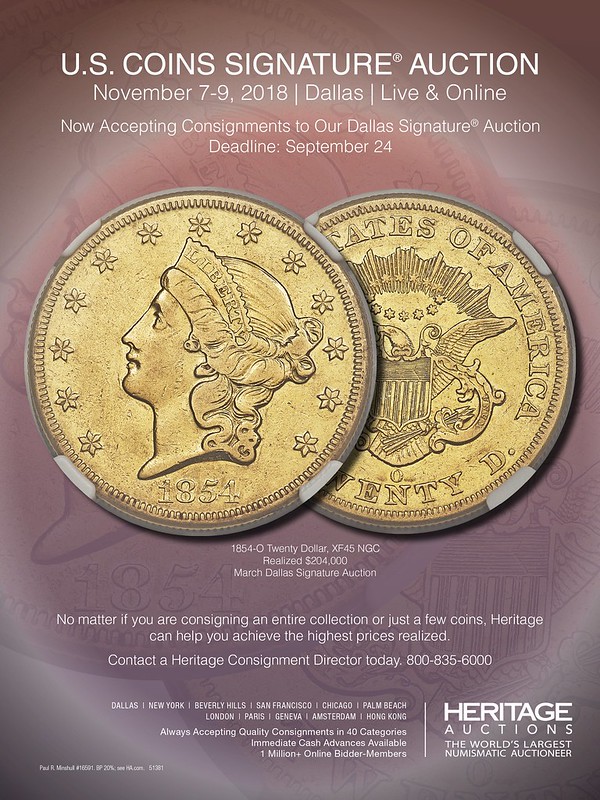
DIX NOONAN WEBB OCTOBER 2018 BANKNOTE SALE
This press release announces the formation of a new banknote department at Dix Noonan Webb in London. The firm will be offering a banknote auction this fall. -Editor
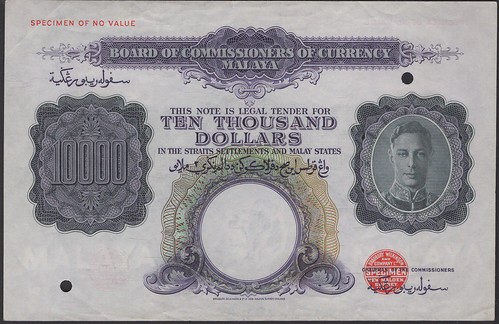
The extremely rare Malaya 10,000 Dollars note is expected to fetch up to £28,000
Rarities from around the world will be auctioned at the first sale held by the new stand-alone banknotes department at international specialists Dix Noonan Webb in London on 2 October 2018. They include a high denomination Malayan specimen note none of which are known to survive in issued form, a 19th century Spanish 500 Pesetas of which even the Bank of Spain does not have an example, and the only number 1 note of the first date of issue of the Irish Ploughman series known to be in private hands.
“We are delighted to be able to be offer such a fine selection of rare notes in our first sale,” said Andrew Pattison, head of the department, who joined Dix Noonan Webb with specialist Thomasina Smith at the beginning of July. Until now banknotes came under the umbrella of the coins department but Pattison and Smith have set up a new separate department working with DNW’s banknotes consultant Michael O’Grady, who continues in his previous role.
The star lot in the 2 October auction is the Board of Commissioners of Currency Malaya colour trial 10,000 Dollars note issued in 1942, which is estimated at £24,000 to £28,000. Such high denomination notes are known colloquially as ‘Titans’ and no issued examples are known. They were used for internal or interbank transfers as they were far too valuable to be carried around in someone’s pocket. This Malayan note has no serial number and is described in the auction catalogue as “an exceptional example of an extreme rarity and a classic design.”
The Banco de Espana specimen 500 Pesetas issued on 1 July 1876 is so rare that not even the Bank of Spain has one in its collection. The example to be offered by DNW is believed to be one of only two known and is the more complete of the two as it is printed on higher quality paper. The note, which has zero serial numbers, is expected to fetch £9,000 to £12,000.

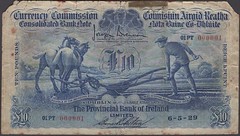
The Spanish 500 Pesetas (left) is one of only two known while the number 1 note from the Irish Ploughman series is thought to be the only one of its type in private hands.
The Irish Currency Commission Provincial Bank £10 from the Ploughman series dated 6 May 1929 has the serial number 1. It is known that four other number 1 notes from the Ploughman series have survived but all of these are either in bank archives or in the National Museum of Ireland. It is believed that the Provincial Bank note to be auctioned at DNW is the only number 1 note of the first date of issue for the Ploughman series in private hands. It is estimated at £7,000 to £9,000.
Other highlights of the sale include an Iranian specimen 5,000 Rials with a previously unknown overprint intended to obscure the image of the Shah immediately after the 1979 revolution which overthrew him. This is expected to sell for £5,000 to £7,000. A rare 1942 specimen Iraqi 10 Dinars portraying King Faisal II as a baby is estimated at £5,500 to £6,500, while a set of eight proofs for the 1927 Hong Kong & Shanghai Banking Corporation 100 Dollars is thought to be unique and should fetch £3,000 to £4,000.
For more information, see:
https://www.dnw.co.uk/auctions/
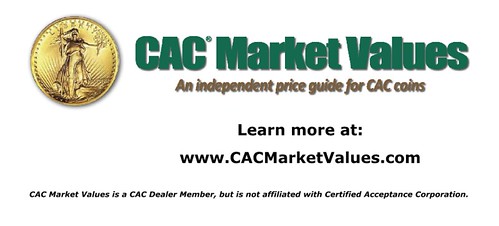
NUMISMATIC NUGGETS: AUGUST 26, 2018
Here's a selection of interesting or unusual items I came across in the marketplace this week. Tell us what you think of some of these. -Editor
Rhodes Didrachm
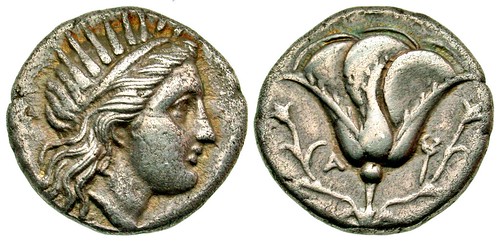
Lot 091. Islands off Caria, Rhodos. Rhodes. AR didrachm. 304-275 B.C. Ex Hays; Ex CNG sale 69.
Islands off Caria, Rhodos. Rhodes. AR didrachm (19 mm, 6.43 g, 1 h). 304-275 B.C. Helios radiate head right / Rose witg two buds flanking, csduceus to right, A to left. SNG Copenhagen 734; Ashton Colossus 12 (A6/P7; this coin); Ashton 166. ..
Nice design, well struck and centered. From Agora Auctions sale #76, closing September 4, 2018. -Editor
To read the complete lot description, see:
Lot 091. Islands off Caria, Rhodos. Rhodes. AR didrachm. 304-275 B.C. Ex Hays; Ex CNG sale 69.
(https://www.agoraauctions.com/listing/viewdetail/40651)
1802 Half Dime
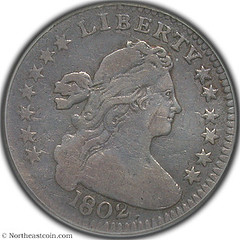
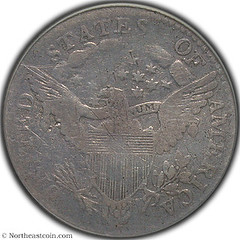
The 1802 Draped Bust Half Dime is a true American rarity. From a low mintage of 3,060, various sources estimate between just 35 and 50 remain today. There are no known Mint State examples. Two AU55 coins listed in the PCGS census claim finest graded status. The VG example we offer here resides in an old green label holder and exhibits a moderate rose-gray patina that lightens considerably when rotated under light. This date is not surprisingly listed in the 4th Edition of the 100 Greatest U.S. Coins.
Indeed. One of the true keys to the U.S. coinage series, the date has been sought after by collectors for nearly 200 years. A respectable example that served the public in circulation. From Northeast Numismatics. -Editor
To read the complete item description, see:
1802 Draped Bust Half Dime PCGS VG10 $157,500
(https://www.northeastcoin.com/featuredCoinDetail.jsp?FtrdCoinId=522)
Houck's Panacea Counterstamp on 1833 Half Dollar
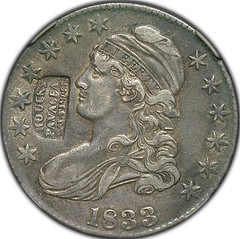
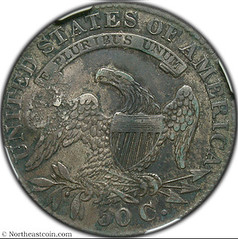
A very popular counterstamp. Jacob Houck was a physician who owned a dry goods store in Baltimore. He developed an elixir which he had patented. He sold his Panacea for $1.50 per bottle which was quite a price back then! A very neat item for the Bust Half or Hard Times Token collector.
Great coin - the counterstamp is placed carefully in the field not affecting the obverse devices. The higher wear on the reverse opposite the counterstamp indicates circulation (because stamping the coin causes a slight bulge on the opposite side). This is evidence that the piece is genuine and saw actual use in daily commerce. Also from Northeast Numismatics. -Editor
To read the complete item description, see:
1833 (1836) Bust Half Dollar Houck's Panacea HT-141 NGC XF40 $1250
(https://www.northeastcoin.com/featuredCoinDetail.jsp?FtrdCoinId=524)
1917 German East Africa 5 Rupie Emergency Note
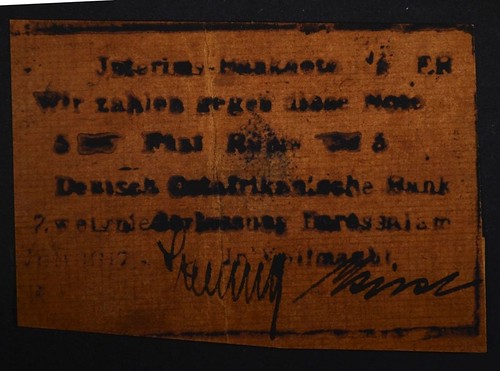
WWI EMERGENCY ISSUE CRUDELY PRINTED LOCALLY DUE TO WARTIME NAVAL BLOCKADE VERY SCARCE CU
I love emergency money of all forms - nearly always rare and historic. -Editor
To read the complete lot description, see:
1917 5 RUPIE #2289 GERMAN EAST AFRICA
(https://www.silvercityauctions.com/1917-5-RUPIE-2289-GERMAN-EAST-AFRICA_i31155387
Liberty Standing Half Dollars Album
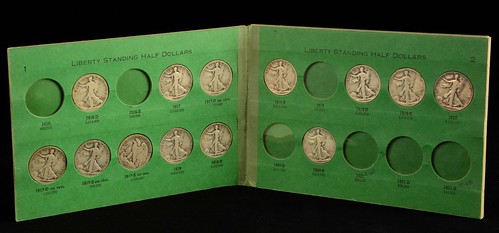
Ranging from 1916 to 1947. Includes two partial albums, 1917-S, 1917-S obverse, and 1917-D. Average circulation. $43.00 face value.
Before the name "Walking Liberty Half Dollars" came into vogue, these were sometimes referred to as "Liberty Standing Half Dollars". The album is more rare and interesting today than the coins. Subsequent lots in the Morphy Auctions sale include similar albums for "Benjamin Franklin Half Dollars" and "Liberty Head Dollars".
I sent a draft of this item to researcher Dave Lange, and he submitted some great background information on these albums - see the next article in this issue. -Editor
To read the complete lot description, see:
Lot Of 86: Walking Liberty Half Dollars.
(http://auctions.morphyauctions.com/Lot_Of_86__Walking_Liberty_Half_Dollars__-LOT446921.aspx)
St. Peters Port Free Milk Token
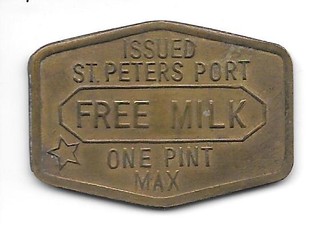
Description: St. Peters Port brass token for one free pint of milk.
Dimensions: 2.5 inches
Tokens for beer are commonly seen but I don't think I've seen one for milk before. This is offered in a Boston, MA sale. Wondering where St. Peters Port was I did a web search and found one not in New England, but Guernsey in the English Channel Islands.
The search also turned up a record on Richard Greever's TokenCatalog.com, which notes: "this token is a fantasy token- j. adams; ref website: http://www.guernsey.net/~sgibbs/numismatics/tokens.html"
That web page no longer exists. But I also found a reference on Ken Barr's web site, where "St. Peters Port, Free Milk" is listed under "L. A. STAMP" OLD WEST FANTASY TOKENS from Stephen P. Alpert's Tokens and Medals: A Guide to the Identification and Values of United States Exonumia, First Edition, 1992.
And finally, I located a listing on Paul and Bente Withers's Galata coins site which describes it as "a fantasy produced in the 1960s." -Editor
To read the complete lot description, see:
Lot 103: Free Milk token (https://www.invaluable.com/auction-lot/-1-c-5CB412CA5A)
To read the complete lot description, see:
TokenCatalog #258926
(https://tokencatalog.com/token_record_forms.php?action=DisplayTokenRecord&td_id=258926&
inventory_id=212375&attribution_id=263849)
To read the complete lot description, see:
Chapter 67. FAKES, FANTASIES, AND RESTRIKES (http://www.kenbarr.com/fantasy.html)
To read the Galata item description, see:
GUERNSEY. Token.
(http://www.galata.co.uk/store.asp?storeAction=showDetail&stockID=11369&stockMasterCategoriesID=261)

WAYTE RAYMOND'S POPULAR ALBUM SERIES
David Lange submitted these notes on the coin albums I discussed in the previous article in this issue - NUMISMATIC NUGGETS. He included several images from his book. Thanks! -Editor

The album shown is part of Wayte Raymond's Popular Album series. These were budget-minded companions to his more expensive National albums, and they offered something a little more sophisticated than the simple folders of Dansco, Oberwise and Whitman. The particular variety illustrated is among several cataloged as RP50cC2 in my book Coin Collecting Albums Volume One, which covers the products of Beistle, Raymond and Meghrig. I can't tell the specific variety without seeing the album's back cover where the publication statement appears.
The Popular line was launched in 1940-41 concurrently with the rise of coin folders, and originally it featured loose leaf pages within a small, landscape format binder. The pages carried no dates, instead just being titled for each denomination. This First Edition was simply a cheaper version of the National Album, and it failed to satisfy either the high end or low end buyer. Examples are extremely rare today, and I have just two of the binders in my own collection, plus a small handful of pages.
Late in 1941 Raymond retooled the Popular Album into the format seen in the auction albums, and these are cataloged in my book as the Second Edition. America's entry into WWII led to paper shortages and aborted this project, with only titles for Indian Head and Lincoln Cents dating from this period. These, too, are exceedingly rare. The earliest albums are easily recognized by their brown printing and binding tape. Production resumed in 1946---briefly with the same color scheme---but quickly converted to the green printing and tape shown in the auction example. The green/green version is not rare for most titles, as it was in production almost continually through the 1950s. The cover artwork was by Dorothy Faxon, sister of Stuart Mosher and husband of Alan Faxon, product manager after Wayte Raymond more or less retired in the mid 1940s.
M. Meghrig & Sons, formerly a distributor of Raymond albums, cloned this product in the late 1940s, calling it alternately the Green Book or G-Line. Marketing their version aggressively in non-numismatic retail outlets, Meghrig soon outsold Raymond, and the Popular Album was gone by 1960. The Green Book line was discontinued shortly afterward, though the company still had NOS examples for sale when I wrote my book.
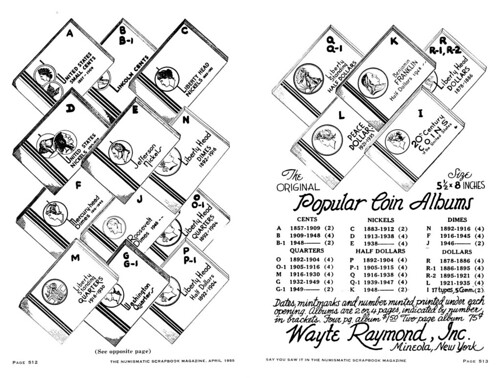
Popular Album ad, April 1955
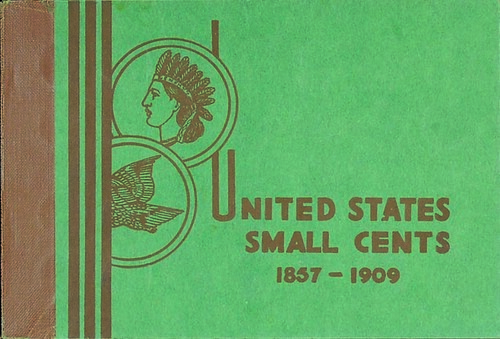
opular Album, 2nd Ed, 1st printing cover, 1941
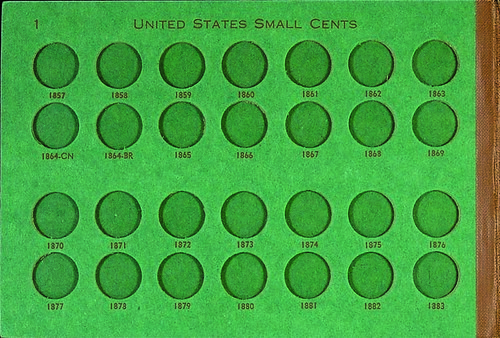
Popular Album, 2nd Ed, 1st printing inside, 1941
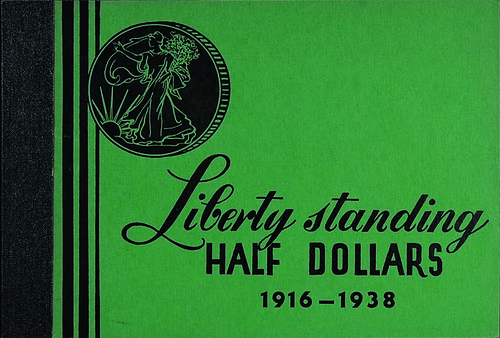
Meghrig Green Book or G-Line

WAYNE'S NUMISMATIC DIARY: AUGUST 26, 2018
The August meeting of my numismatic social group Nummis Nova was delayed a week due the the American Numismatic Association World's Fair of Money in Philadelphia. On Tuesday the 21st I headed to Bowie, MD after work. Julian Leidman was our host and we were meeting at Jerry's Seafoods, home of the Crab Bomb.
We had a low turnout due to the post-convention lull and distance from our usual Northern Virginia haunts. But a fine time was had by the attendees, which besides Julian and myself were our guest Michael Merrill and regulars Jon Radel and Steve Bishop.
As usual I brought along recent numismatic literature acquisitions including Dave Bowers new Vermont Copper book and John Dannreuther's two part volume book on United States proof gold coins still in shrinkwrap. I toyed with the idea of filming an "unboxing" video but opted to keep the books protected from the cornucopia of food our server brought out, from soup and appetizers to the famous Crab Bombs (Michael and I got the spicy Firecracker versions).
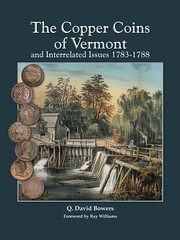
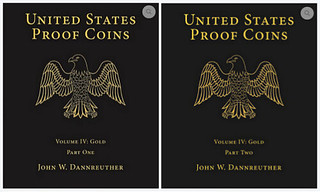
For more information on the books, see:
NEW BOOK: THE COPPER COINS OF VERMONT (http://www.coinbooks.org/v21/esylum_v21n25a03.html)
NEW BOOK: U.S. PROOF GOLD COINS VOL IV: GOLD (http://www.coinbooks.org/v21/esylum_v21n07a02.html)
Julian asked Michael if he remembered Carl Carlson. He did, and recounted a story about visiting Carl in 1975 when he was the numismatic curator at Evergreen House in charge of Johns Hopkins University's Garrett collection. Carl asked Michael if he'd like to see some of the coins. After receiving an affirmative reply (Duh, who would say no?), Carl reached down to the floor and pulled back a large oriental rug. Beneath it was a hidden hatch which opened to reveal a set of stairs. Carl descended and returned with a tray of coins.
The tray included some gorgeous U.S. silver dollars. Michael asked if he could pick some up for a closer look. He got the OK, but then managed to drop one, which hit the edge of the table on the way to the floor. Mortified, Michael profusely apologized. Carl said "Before, that was the finest known." After a pause, he continued: "and it's still the finest known."
Michael also remembered visiting Evergreen House for a lecture by Louis Eliasberg about his own top-notch U.S. coin collection. Eliasberg was able to start forming it in the 1930s when he was a businessman fortunate to have money during the Great Depression. Eliasberg's wealth came after he founded the Finance Corporation of America.
Later in the evening the discussion turned to Dell Loy Hansen's quest to extend Eliasberg's feat to the present day. Michael asked Julian about the Hansen 1866 Liberty Seated Dollar. Julian recalled that he sold the piece to Jimmy Hayes for $850. That was a lot of money at the time (probably the 1970s), but the coin was and remains the finest known.
Julian adds:
The 1866 is part of the Hansen collection, previously from the Trade Dollar Nut collection. I am certain that it is the finest collection of Seated Dollars in existence. The coin is THE finest known Seated Dollar, period!
Steve's Beauties
Steve Bishop brought a number of interesting items, as usual. He kindly forwarded these images.

1762 over 0 2 Kopecks (Overstruck)
This was a little tough to view in person, but the 2 overstuck on the 0 is clearly evident. Scarce piece.
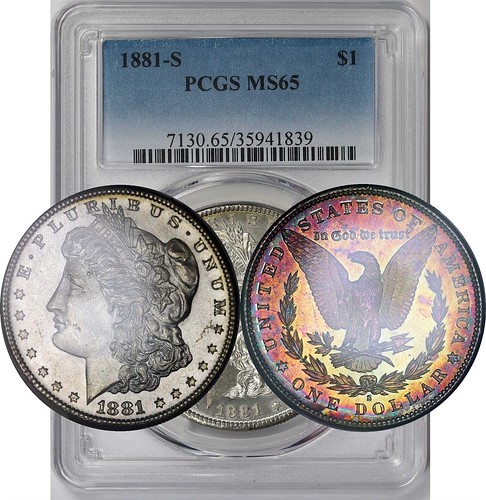
1881-S Morgan PCGS MS65 Toned
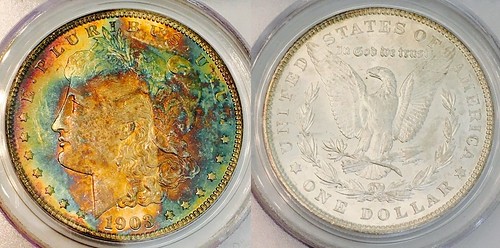
1903 Morgan PCGS MS64 Toned
Steve's great for picking up nice toned dollars. The 1881-S is a beauty.
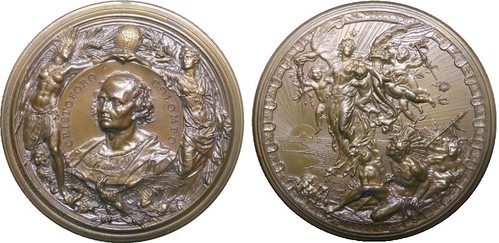
A busy design, but still a nice medal.
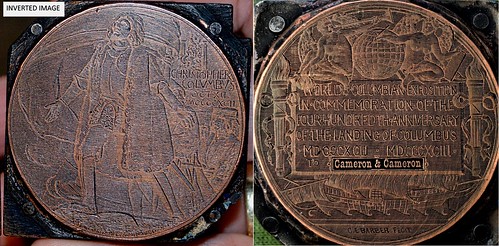
Steve kindly reversed the images for us - these printing blocks are hard to read in reverse. I wonder what publication they were made for? Steve mentioned that it could have been a newspaper as well as a book.
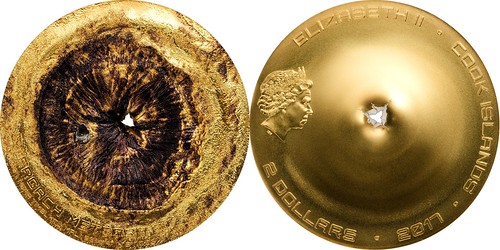
2017 Cook Islands $2 (Chergach Meteorite)
We enjoyed looking at this one. An unusual modern piece. What a great variety of nice numismatic stuff!
As the evening wore down I gathered my things and bid the group adeiu. It was a fun and enjoyable dinner. Next month's meeting will roll around soon as we get back onto our regular schedule. I'll be our host in Ashburn, VA.
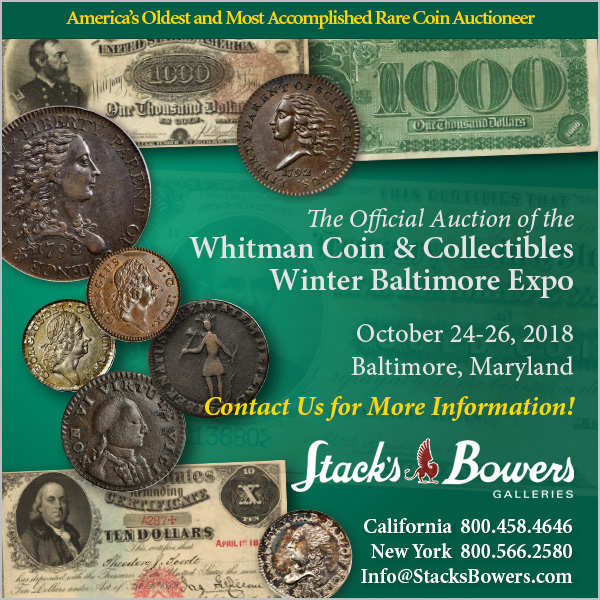
KELLEN HOARD'S 2018 WORLD'S FAIR OF MONEY REPORT
Young numismatist Kellen Hoard of Seattle, WA submitted this report of his trip to the ANA's World’s Fair of Money in Philadelphia last week. -Editor
One of my favorite numismatic events of the year is the American Numismatic Association’s World’s Fair of Money held each August. The show took place in Philadelphia this year, and between my own observations and talking with others, it seemed to be excellent convention.
I flew out to Philadelphia on Wednesday, August 15th. The flight was long, but I got there in time to order an Uber and speed to the convention center. Once there, I was able to spend some time in Stack’s Bowers lot viewing, looking at a variety of Pine Tree shillings, Stellas, and the 1913 Liberty Head nickel. From lot viewing I walked over to the Rarities Night auction. The big focus of this auction was, of course, the nickel, and as the lot got closer more and more people filed into the room. Eventually, the fabled lot arrived, and a collective breath was drawn, only for the coin to receive no new bids and sell for the pre-bid of $4.5 million. In the five-minute break following the coin’s sale, the room quickly cleared, and I followed the stream of people out the door and to my hotel.
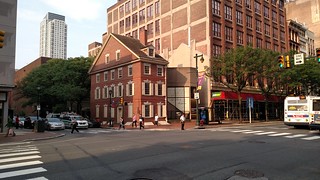 On Thursday morning, I woke up early so that I could take a historical walk with my mother, E-Sylum editor Wayne Homren, and NBS historian Joel Orosz. We had
decided to recreate the walk Thomas Jefferson took on July 11, 1792 to deliver silver to the mint for coining into half dismes. We started where the State Department offices once
stood, which was where Jefferson worked at the time. From there we crossed the road to observe the site of Jefferson’s old home, now converted into a parking lot. A short jaunt
down the street brought us to a recreation of the home where this same man had written the Declaration of Independence.
On Thursday morning, I woke up early so that I could take a historical walk with my mother, E-Sylum editor Wayne Homren, and NBS historian Joel Orosz. We had
decided to recreate the walk Thomas Jefferson took on July 11, 1792 to deliver silver to the mint for coining into half dismes. We started where the State Department offices once
stood, which was where Jefferson worked at the time. From there we crossed the road to observe the site of Jefferson’s old home, now converted into a parking lot. A short jaunt
down the street brought us to a recreation of the home where this same man had written the Declaration of Independence.
From there, we walked north along 7th street to reach the location of the first Philadelphia mint. Now a massive, high-security federal building, it still felt momentous to stand across from the spot where the tiny mint had once stood. Our group continued north to look upon the spot where David Rittenhouse had once lived before we completed the final stretch of our journey to where John Harper’s cellar used to be. The walk was quite fascinating. Joel and Wayne’s commentary throughout the expedition provided excellent historical context, and it was a great kickoff to my trip.
From Harper’s cellar, it was a quick walk to the convention center. Once I reached the bourse, I made my way over to the numismatic literature section. Kolbe & Fanning, Charles Davis, and the Numismatic Bibliomania Society were next to each other. I took up the helm of the NBS table for a little while, before heading down to the NBS symposium at 1. Roger Burdette was the presenter for this year’s symposium, and he gave a great talk on numismatic research, with a focus on the National Archives.
From that talk I immediately walked over to an ANA Money Talk next door, where Q. David Bowers, Steve Hayden, Fred Holabird, Neil Musante, and Jeff Shevlin were doing a panel on tokens and medals. Susan Trask moderated the panel, and I learned a lot throughout the hour they spoke. Afterwards, I made my way over to Heritage Lot Viewing, where I was able to look at the 1792 Washington gold eagle and other pieces. The rest of my day was spent volunteering at the NBS table.
After the show closed for the day, I was able to meet up with Coin Week editor Charles Morgan and Sample Slabs author David Schwager for a captivating conversation. During the meeting, they invited me up to the NLG Bash, which I had never attended before. I decided to see what it was like, and it was an enjoyable experience. The food was delicious, but I heard attendance was lower than it had been in previous years.
On Friday morning, I walked straight to the bourse floor and spent some time among the dealers and volunteering at the NBS table. At 11:30, the NBS held its general meeting, where attendance was good and the benefit auction results were strong. Afterwards, I went out to lunch at the nearby Reading Market with Craig Sholley and Rob Rodriguez. I learned a lot through conversing with both of them, and the food we picked up at Herschel’s East Side Deli was delicious. Then I spent some more time on the bourse floor talking with Shanna Schmidt and various other dealers before meeting up with Len Augsburger and my mother for an Uber to a French restaurant nearby, Bistro La Minette.
Each year, Joel Orosz, Len Augsburger, Wayne Homren, Len’s wife Deb, my mother, and I go out to dinner the Friday night of the convention. The dinner and conversation were as great as always, and it remains one of my favorite parts of the entire trip.
I woke up early again on Saturday morning so that I could attend the ANA Board of Governors meeting. After the session was over, I walked to a nearby USPS to mail off several of the books I had purchased during the convention. From there, my mother and I stopped by the National Constitution Center, Philadelphia Mint, Liberty Bell, and Independence Hall before we headed back to the airport and took off for home.
The show was extremely fun to attend, as always. It was great to see many of the people I know but did not mention in this report, such as Young Numismatist of the Year Abby Zechman, ANA Educator Sam Gelberd, Heritage Senior Cataloger Mark Borckardt, and many others. If the ANA show is ever in your area, I highly recommend attending, for it is an extremely enjoyable show.
Thanks, Kellen! Nice report. Online numismatics is great, but there's no substitute for pressing the flesh at a national convention. Chicago and Pittsburgh are next in line for the annual WFOM. -Editor
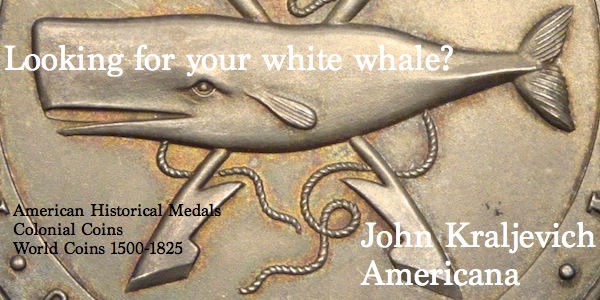
2018 WORLD'S FAIR OF MONEY EXHIBITS
I pulled together a four-part Numismatic Diary article last week, but didn't have time to include anything on the great exhibits at the American Numismatic Association's World's Fair of Money in Philadelphia. Here are some photos I took of the three numismatic literature exhibits, and a few other exhibits that particularly caught my eye. It was a high-quality exhibit area - many thanks to all the exhibitors who participated. -Editor
1st Place: Publications By Charles T. Steigerwalt
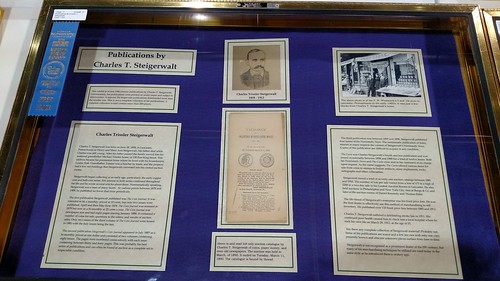
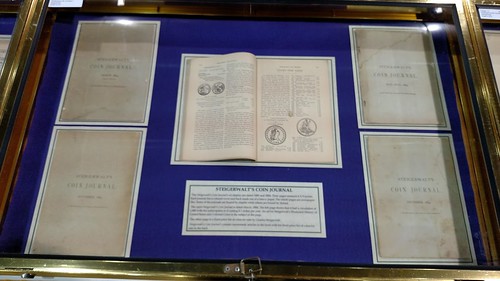
2nd Place: Buy the Books For the Coin
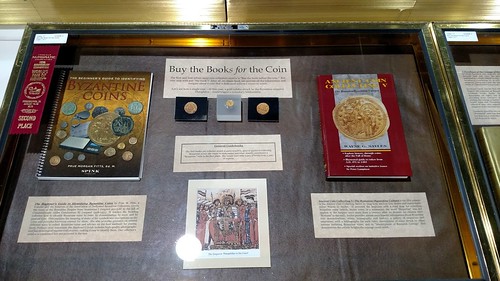

3rd Place: Special Medals for U.S. Government Agencies
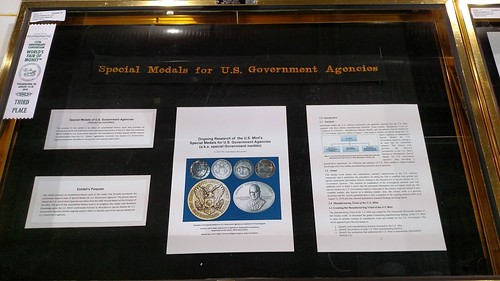
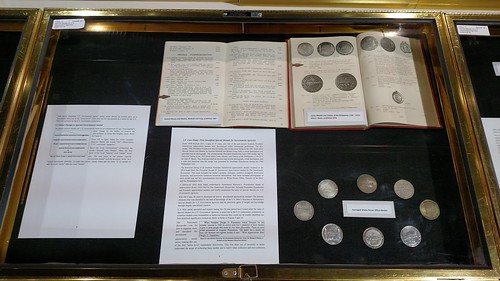
Some Other Exhibits
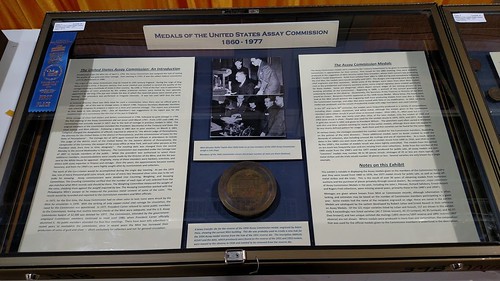
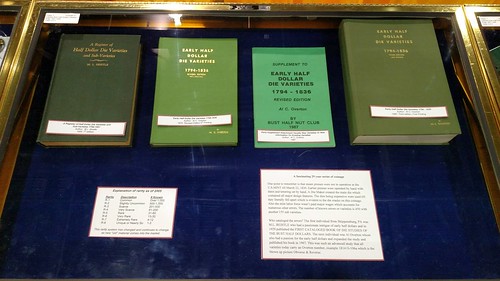
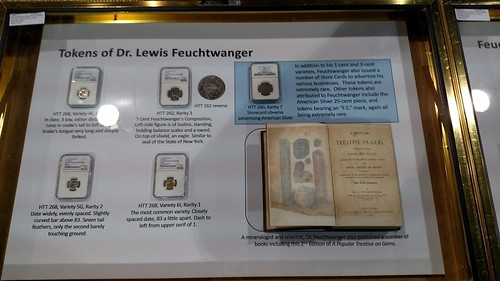
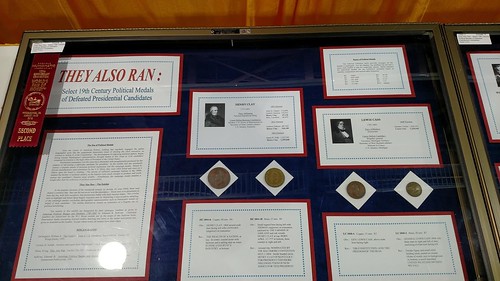
All of the photos I took at the Philadelphia World's Fair of Money show have been loaded onto albums on our Flickr image archive. Have a look!
2018 ANA NBS General Meeting
(https://www.flickr.com/photos/coinbooks/albums/72157698742231291)
2018 ANA NBS Symposium (https://www.flickr.com/photos/coinbooks/albums/72157697164073832)
2018 ANA Jefferson Walk (https://www.flickr.com/photos/coinbooks/albums/72157700359170555)
2018 ANA Money Talks (https://www.flickr.com/photos/coinbooks/albums/72157694535009700)
2018 ANA NBS Table (https://www.flickr.com/photos/coinbooks/albums/72157697164113932)
2018 ANA Tables (https://www.flickr.com/photos/coinbooks/albums/72157698742404731)
2018 ANA NLG Bash (https://www.flickr.com/photos/coinbooks/albums/72157670302250547)
2018 ANA Rittenhouse Breakfast
(https://www.flickr.com/photos/coinbooks/albums/72157694535470860)
2018 ANA Exhibits (https://www.flickr.com/photos/coinbooks/albums/72157700358962155)
2018 ANA Other (https://www.flickr.com/photos/coinbooks/albums/72157694535433650)
To read the earlier E-Sylum articles, see:
WAYNE'S NUMISMATIC DIARY: AUGUST 19, 2018: PART 1 (http://www.coinbooks.org/v21/esylum_v21n33a25.html)
WAYNE'S NUMISMATIC DIARY: AUGUST 19, 2018: PART 2 (http://www.coinbooks.org/v21/esylum_v21n33a26.html)
WAYNE'S NUMISMATIC DIARY: AUGUST 19, 2018: PART 3 (http://www.coinbooks.org/v21/esylum_v21n33a27.html)
WAYNE'S NUMISMATIC DIARY: AUGUST 19, 2018: PART 4 (http://www.coinbooks.org/v21/esylum_v21n33a28.html)
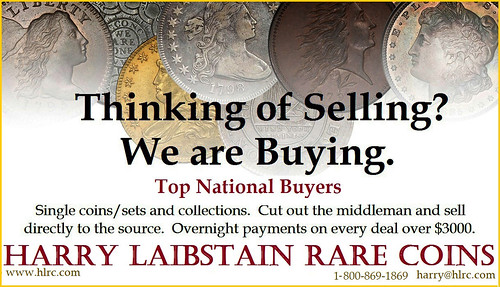
COINS FROM THE WRECK OF LE CHAMEAU
Pablo Hoffman forwarded some articles inspired by the passing this week of treasure hunter Alex Storm. The first is from a 2013 Canadian Coin Blog. -Editor
 One of the most important shipwrecks ever found in Canadian waters was the wreck of Le Chameau. On the night of August 27, 1725, the future of Colonial French Canada was
dashed to pieces on the rocks off Cape Lorembec, Cape Breton Island, Nova Scotia. The 600-ton, 48-gun pride of the French fleet, Le Chameau, was lost with all of her 316
passengers and what amounted to several years’ worth of funds for the French colonies in North America in newly struck silver Ecu and half Ecu coins.
One of the most important shipwrecks ever found in Canadian waters was the wreck of Le Chameau. On the night of August 27, 1725, the future of Colonial French Canada was
dashed to pieces on the rocks off Cape Lorembec, Cape Breton Island, Nova Scotia. The 600-ton, 48-gun pride of the French fleet, Le Chameau, was lost with all of her 316
passengers and what amounted to several years’ worth of funds for the French colonies in North America in newly struck silver Ecu and half Ecu coins.
After resting on the ocean floor for close to 250 years, Le Chameau was rediscovered by a local diver and entrepreneur named Alex Storm and his associates, who began recovering contents of the ship that had eluded the French salvors of 1726. They discovered mounds of cannonballs, iron-encrusted artifacts and a group of silver and gold coins. After more than a month of intensive work on the wreck site, Storm and his associates were able to bring to the surface many historically significant artifacts, along with approximately 30,000 livres in coins. These were mostly French Ecu and half Ecu coins featuring the Royal Arms of France on one side, and King Louis XV on the other. Most of the silver coins were corroded after their long exposure to the turbulent salt water and sand, but all are still highly collectible today as relics of this important piece of Canadian history. The largest part of the coins that were originally aboard Le Chameau have never been recovered.
To read the complete article, see:
The Wreck of Le Chameau
(https://canadiancoinblog.wordpress.com/2013/04/15/
the-wreck-of-le-chameau/comment-page-1/)
See also:
https://en.wikipedia.org/wiki/French_ship_Chameau
Alex Storm, Cape Breton’s treasure hunter and
historian, dies at age 80 (https://www.thestar.com/halifax/2018/08/15/alex-storm-
cape-bretons-treasure-hunter-and-historian-dies-at-age-80.html)
KLIMT ON COINS
Lou Golino published a beautifully illustrated article on Coin Update August 24, 2018 about coins featuring or related to the artist Gustav Klimt. Here's an excerpt - see the complete article online. -Editor
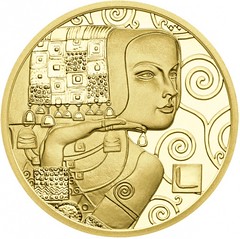
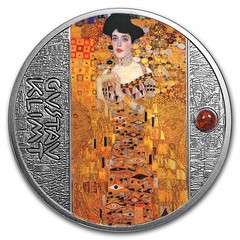
Gustav Klimt (1862-1918), an Austrian symbolist painter, was a founding member of the Art Nouveau and Vienna Secessionist movements — both of which were reactions against the more traditional style of 19th-century art.
Klimt went through several different artistic phases and styles in his career, starting out as a traditional painter, but is best known for his depictions of the female form, which at the time were typically perceived as controversial because of their frequently erotic nature. He is also well-known for his landscapes, allegories, and many other types of paintings — each of which was highly detailed works that have been called “paintings within paintings.” His very distinctive style during his mature phase was marked by the use of decorative elements, ornaments, and contrasting colors.
Klimt was the son of a gold engraver father and an opera singer mother and one of seven children. The influence of his father’s profession is very evident in his golden period works that used gold leaf paint, including his very famous 1907 portrait of Adele Bloch-Bauer that was commissioned by her husband, a banker and sugar producer.
To read the complete article, see:
Klimt on coins (http://news.coinupdate.com/klimt-on-coins/)

MORE COLLECTIVE "JIGSAW PUZZLE" COIN DESIGNS
Pabitra Saha kindly provided these additional examples of "Jigsaw puzzle" coin designs, where multiple coins can be placed together to create a larger design. Thanks! -Editor
The first set came out in 2003 on the centenary of the Tour de France cycling race. It preceded Mathew Dent design and the cycle chain is common thread. The second one came out in 2013 and shows "RF".

Bicycle chain design
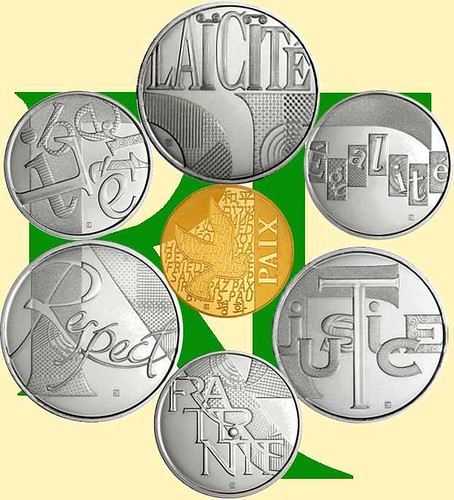
"RF" for "Republique Francaise"
To read the earlier E-Sylum article, see:
MOLDOVA'S COLLECTIVE "JIGSAW PUZZLE" COIN DESIGNS
(http://www.coinbooks.org/v21/esylum_v21n33a21.html)

RUSSIAN ARCHEOLOGISTS DISCOVER BEARD TOKEN
Dick Hanscom and John Regitko forwarded this Daily Mail article about a Russian beard token found by archeologists. -Editor

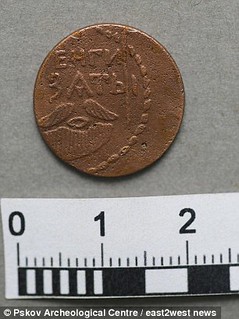
Russian archeologists have found an exceptionally rare 'beard kopek' - a coin that men had to buy under Peter the Great if they wanted to remain unshaven.
Minted in 1699, the copper money is only the second known example of the coin that still survives today, and has been described by experts as 'priceless'.
It shows an image of a beard and moustache and the words 'Money Paid'.
The kopek was part of Peter the Great's 'beard tax' imposed soon after he returned from an incognito trip to Britain in 1697 to learn about Western ways in his bid to modernise Russia.
As part of the modernisation imposed after his trip, Peter the Great banned all facial hair unless people paid for a special coin that made them exempt from the rule.
The newly found coin was discovered in a ruined 17th Century building in the Russian city of Pskov alongside a haul of 5,000 other ancient coins.
The wealthy had to fork out high sums but peasants paid one kopek - the lowest coin of the realm.
The 'beard kopeks' acted as a token proving those with facial hair had paid and were expected to be carried at all times.
Currently only one other example is known to exist of these coins - and it is held in the Hermitage Museum in St Petersburg.
In 1728 - three years after Peter's death - the beard tax coins were removed from circulation, melted down, and made into other money.
Second known? Priceless? I know most of the beard tokens we see today are novodels made by the Russian mint to satisfy collectors. Is this discovery an original piece? It does not have a counterstamp, which was used to signify the payment of an additional year's tax, so perhaps this came from the first year of issue. I asked Steve Bishop to help straighten me out. Thanks. -Editor
Steve writes:
I used to own an original beard token. They are generally dated (in Cyrillic) 1705 (round) or 1725 (rhombic). I think the 1699 version is what they are referring to as "second known" and "priceless".
To read the complete article, see:
'Priceless' 300-year-old coin that
men had to buy to avoid Peter the Great's 'Beard Tax' in Russia is discovered in a ruined 17th Century building
(http://www.dailymail.co.uk/sciencetech/article-6095311/Priceless-300-year-old-coin-men-buy-avoid-Russian-Beard-Tax-Pskov.html)
To read an earlier E-Sylum article, ee: MORE ON THE RUSSIAN BEARD TOKENS (http://www.coinbooks.org/esylum_v15n47a14.html)

TANK MUSEUM EXHIBITS VICTORIA CROSS MEDALS
The Daily Echo of Bournemouth, England published an article about an exhibit of Victoria Cross medals at the local Tank Museum. -Editor
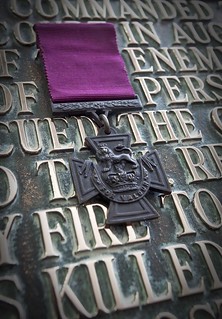 DESCENDANTS of the four Tank Corps men who were awarded Victoria Crosses posthumously in World War One have assembled for the opening of a new exhibition in Dorset.
DESCENDANTS of the four Tank Corps men who were awarded Victoria Crosses posthumously in World War One have assembled for the opening of a new exhibition in Dorset.
he four VCs, which have been brought together for the first time, are on display at The Tank Museum in Bovington.
Prior to the opening of the exhibit, members of the current Tank Regiment read the citations explaining the bravery displayed by the men who won the medal.
The Victoria Cross is the British armed forces highest medal for gallantry in the presence of the enemy.
Ian Robertson, the great nephew of recipient Clement Robertson said: "I am deeply proud and wear his replica medals.
"The bridge where he died is called Robertson’s Bridge and has been upgraded to memorial status."

To read the complete article, see:
Tank Museum's Great War Victoria Cross exhibition opens
(http://www.bournemouthecho.co.uk/news/16594615.tank-museums-great-war-victoria-cross-exhibition-opens/)
EAGLE SCOUT MEDAL OWNER SOUGHT
On August 24, 2018 the Scouting Magazine blog published a plea to find the owner of a lost Eagle medal. -Editor
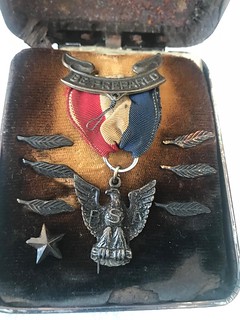 When a Scout from North Carolina found, among his grandmother’s possessions, an old Eagle Scout medal and six Eagle Palms, his reaction was instant.
When a Scout from North Carolina found, among his grandmother’s possessions, an old Eagle Scout medal and six Eagle Palms, his reaction was instant.
“I wish we could return it to its owner,” he told his mom.
Hayden Stanley is a First Class Scout in Troop 334 of Raleigh, N.C. As someone on the trail to Eagle himself, he knows how much work goes into earning the program’s highest rank.
Hayden knew the medal didn’t belong to anyone in his family. And his grandmother died two years ago, so Hayden and his parents aren’t able to ask her how she came in possession of the Scouting artifact.
“I can only speculate,” says Hayden’s dad, Dwight. “In retirement, my parents would often go to auctions in Fayetteville, N.C., and many times they would bring home boxes of random stuff auctioned off as a lot.”
For background I reached out to George Cuhaj, author of the Standard Price Guide to U.S. Scouting Collectibles (Standard Price Guide to U.S. Scouting Collectibles (Krause Publications, Iola WI, 2001 (C) George S. Cuhaj. 400 pages). Autographed copies are available from the author for $11.50 postpaid media mail. G.S. Cuhaj P.O. Box 433, Iola WI 54945. -Editor
George writes:
There are plenty of them with or without IDs available on eBay. The box has been damaged in a fire. The retail value of the medal is 65-80 dollars. The palms are awarded for each 5 merit badges earned above the 21 required (or 24 for a brief time in the 1970s).
So there would be 1 bronze palm for 5, 1 gold for 10, 1 silver for 15, and then it would start combinations, 1 silver and 1 bronze for 20, 1 silver and 1 gold for 25 and 2 silvers for 30...(for a total of 51 or 54 merit badges.). Currently a scout can earn about 134 merit badges in the program.
(Some folks on-line have surmised that they are all silver palms, thus indicating the scout earned 90 merit badges above his 21 (or 24) thus putting him near the max available in the 1970s.
The Manufacture of this variety was the Stange Co. who held the contract from 1968-1999, at about 30-40 thousand awards each year. There are varieties, and generally common.
This is a link to the official annual totals.
https://blog.scoutingmagazine.org/2017/03/01/number-of-eagle-scouts-per-year/ .
Thanks, George. See the article for more details. -Editor
George adds:
I am generally not in favor of trying to find the original owners or the family of original owners. Just finding out about them thru ancestry or SSI information, or Newspapers.com is fine. There is usually a reason that something gets sold.
Good point, although one never knows the true situation without investigating. Sometimes the recipient or their families are happy to relocate lost medals. But I believe a marketplace should exist, as collectors provide a means to preserve medals and research their history long after the families cease to have an interest in them. -Editor
To read the complete article, see:
This Scout found a lost Eagle medal. Can we help him get it back to its
owner? (https://blog.scoutingmagazine.org/2018/08/24/can-we-get-this-eagle-medal-back-to-its-owner/)
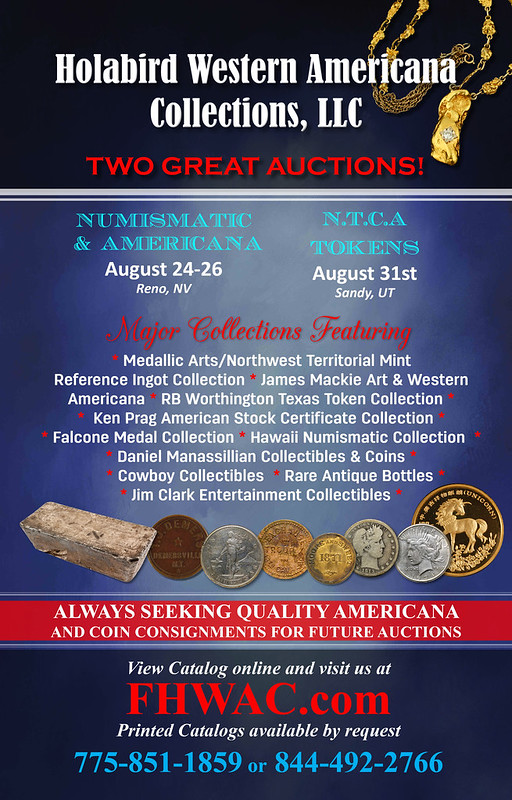
WYTHEVILLE, VA VOUCHERS
The Summer 2018 issue of The Virginia Numismatist from the Virginia Numismatic Association has an interesting article by R. Neil Hening and Robert W. Tharpe on vouchers issued in Wythe County, VA during the Civil War. Editor Tom Kays kindly sent me the text and images for this excerpt. Thanks! -Editor
The authors discovered nine “vouchers” from Wythe County, Virginia, which were issued to family members of soldiers away in military service. In their book, Virginia Obsolete Paper Money, Richard Jones and Keith Littlefield attribute these vouchers to the military, however, the Order Book for Wythe County reveals a civilian authority issued this “local benevolence.”
On September 9, 1861, the justices of the Wytheville Court provided for support of local families who had family members serving in military units of Virginia or the Confederate States of America. Initially no amount of money was appropriated for this effort, but on December 8, 1862 the court appropriated the sum of $15,000.
Although not addressed in the court order, apparently it was left up to the commissioners to determine a family’s eligibility, and the amount to be distributed. The amount of each voucher was usually relatively small; $4.00, $5.00, $6.00 and $8.00. Exceptions included larger amounts of $10.00, $15.00, and an impressive voucher for exactly $62.52. One voucher dated in 1864, distributed “one bunch of cotton” [attesting to exhausted finances late in the war.]
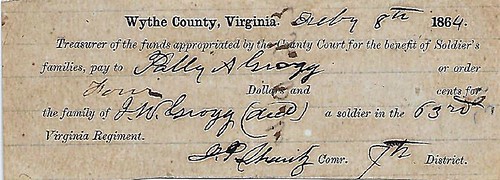
Pre-printed Wythe County 7th District Voucher for Four Dollars issued on December 8 th , 1864 to Polly A. Grogg, for the family of J. W. Grogg, (deceased) of the 63 rd Virginia Regiment.
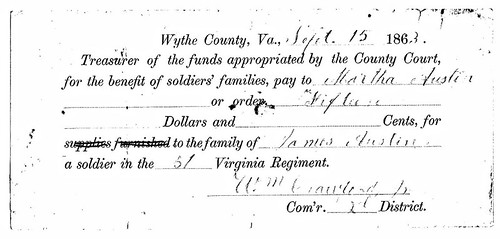
Pre-printed Wythe County 2nd District Voucher for Fifteen Dollars issued on September 15th, 1863 to Martha Austin, for the family of James Austin, 51 st Virginia Regiment.
Perhaps the most interesting information contained in the vouchers is the family name of the soldier who received support from the county. As a case in point, a voucher given to Martha Austin on September 15, 1863 can be used to determine the name of her husband who, according to the voucher, was serving in the 51st Virginia Regiment. Given that there is a regimental history that lists all members of the 51st Virginia Regiment, we can see the service record of James Austin. His service record indicates that he enlisted in Company H, as a private, on 4/9/1862, was taken prisoner at Waynesboro, sent to Harper’s Ferry, and then on to Ft. Delaware on 3/12/1865. He was released on 6/19/1865.
For more information on the Virginia Numismatic Association, see:
http://www.vnaonline.org/
LOOSE CHANGE: AUGUST 26, 2018
Here are some additional items I came across in the media recently that may be of interest. -Editor
Dillon Gage Offers Blockchain DGGold
A press release published on Mint News Blog announces the latest in a series of new products attempting to tie physical specie ownership to new cryptocurrencies. -Editor
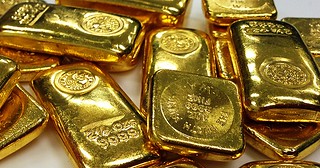 Dillon Gage Metals, one of the world’s largest precious metals wholesale firms and technology innovators in the industry, recently launched its first Digital Metals
product: DGGold.
Dillon Gage Metals, one of the world’s largest precious metals wholesale firms and technology innovators in the industry, recently launched its first Digital Metals
product: DGGold.
Unlike exchange-traded funds (ETFs), DGGold represents 100 percent direct ownership of investment-grade, pure physical gold. The title is maintained by a cryptographically-secure blockchain database that investors can utilize to verify ownership. The physical gold is securely stored in the vaults of the Royal Canadian Mint and is fully deliverable upon request at any time.
To read the complete article, see:
Gold goes digital: Dillon
Gage introduces DGGold future of direct physical gold ownership, now available to investors
(http://mintnewsblog.com/gold-goes-digital-dillon-gage-introduces-dggold-future-of-direct-physical-gold-ownership-now-available-to-investors/)
To read an earlier E-Sylum article, see:
LIBERTY DOLLAR RESURRECTED AS CRYPTOCURRENCY (http://www.coinbooks.org/v21/esylum_v21n25a40.html)
Gold Certificate Denomination Mispelled
I didn't get this one in last week; a Coin World article by Arthur Friedberg discusses Doug Murray's discovery of a whopper of a mistake on an 1882 gold certificate. We'll look forward to his upcoming article with Peter Huntoon in an upcoming issue of Paper Money from the Society of Paper Money Collectors. -Editor
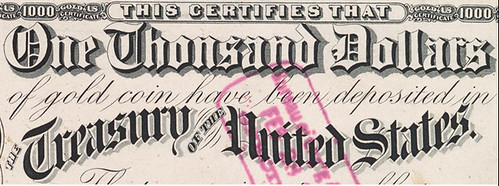
Your eyes do not deceive you: The word “thousand” is misspelled “thonsand” on this Series 1882 $1,000 gold certificate proof. The error was at one point caught by a BEP proofreader, but it was not corrected
To read the complete article, see:
A ‘thonsand’ dollar Series 1882 gold certificate?
(https://www.coinworld.com/news/paper-money/2018/08/thonsand-dollar-note-overlooked-for-130-years.html)
Website Enables Purchases Direct From World Mints
Dave Harper of Numismatic News discusses a new web site that enables collectors to purchase new issues directly from mint around the world. -Editor
To read the complete article, see:
Will collectors like new coin buying website?
(http://www.numismaticnews.net/buzz/will-collectors-like-new-coin-buying-website)


